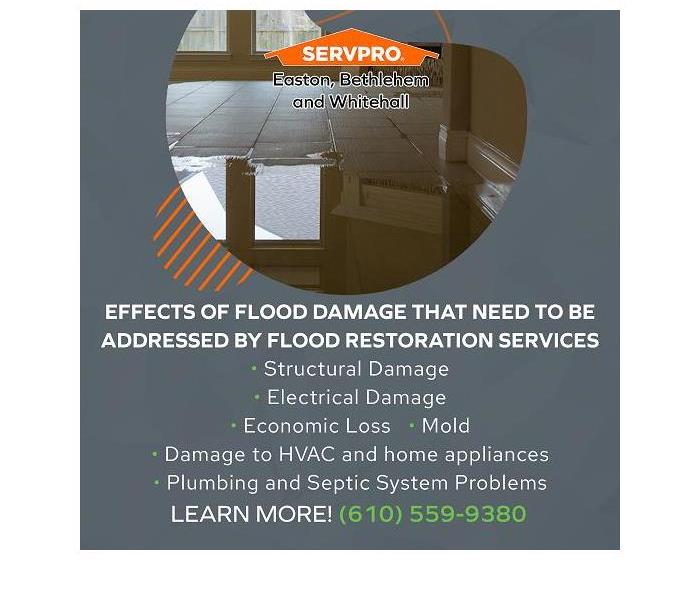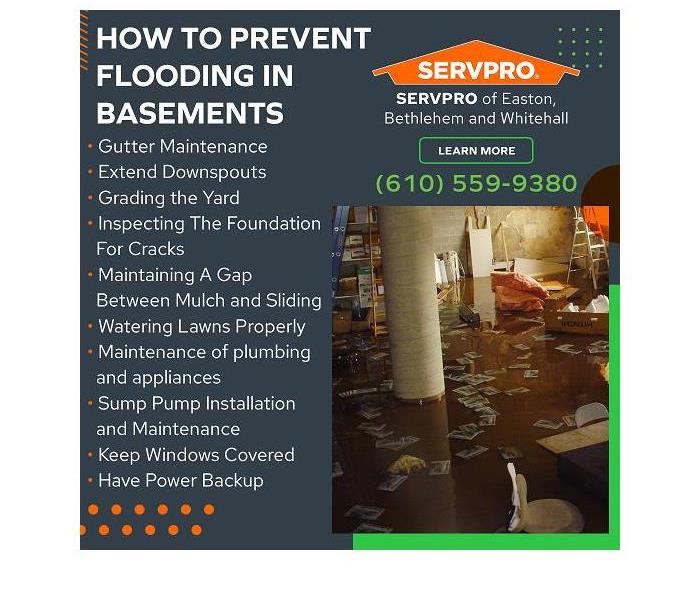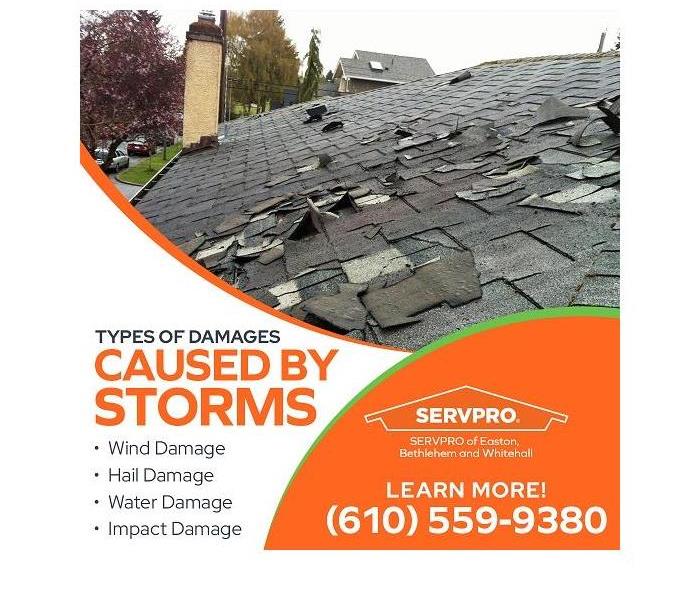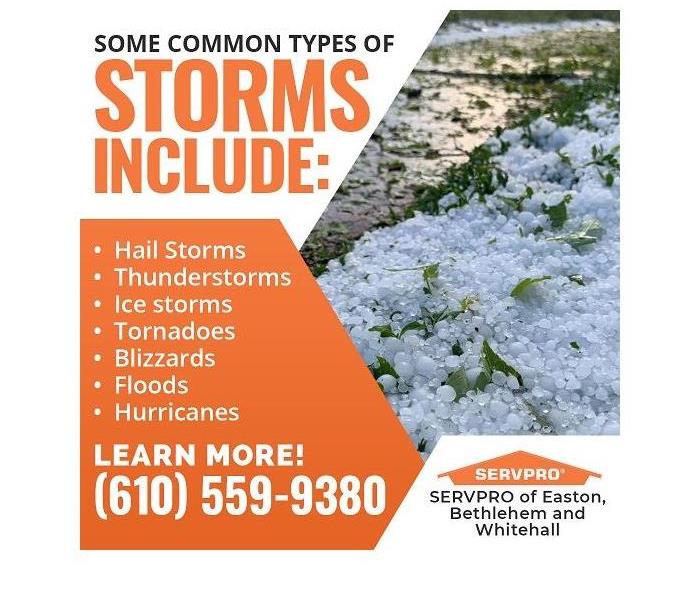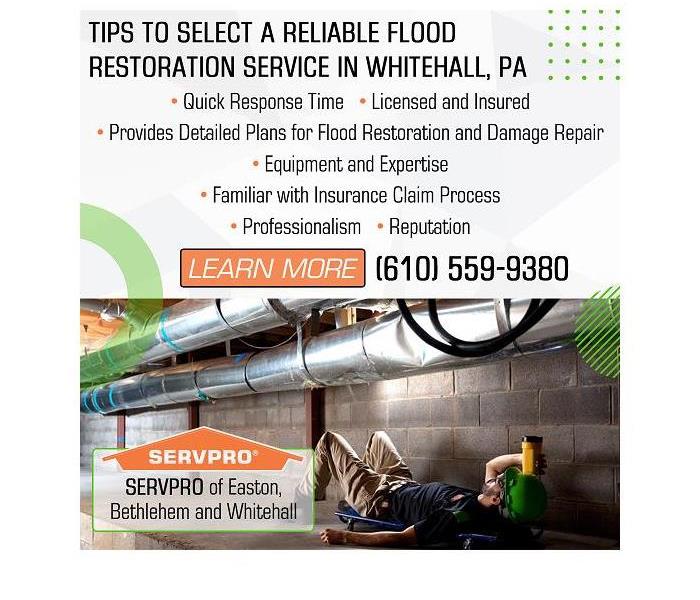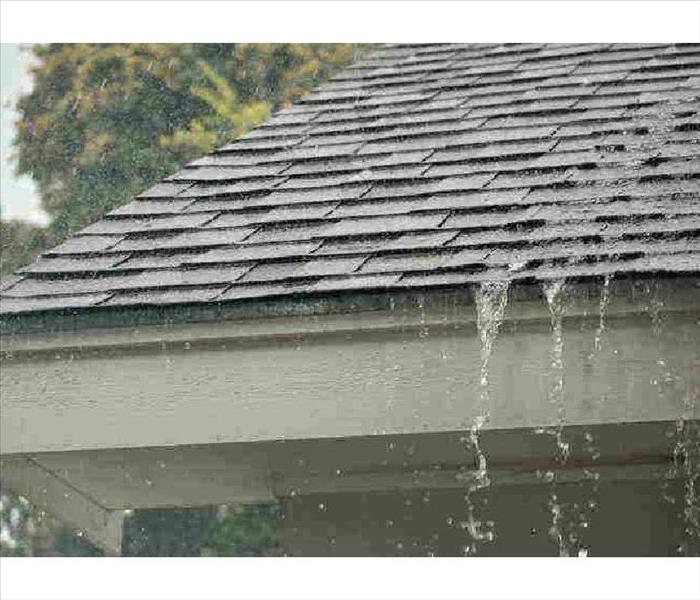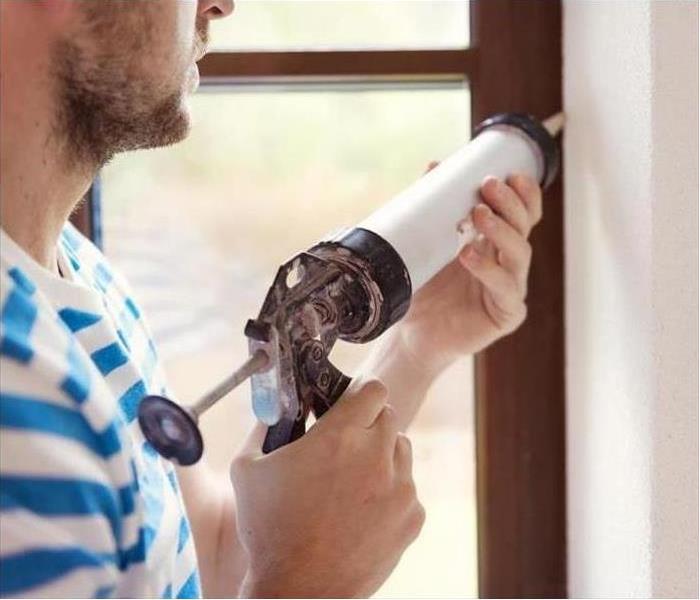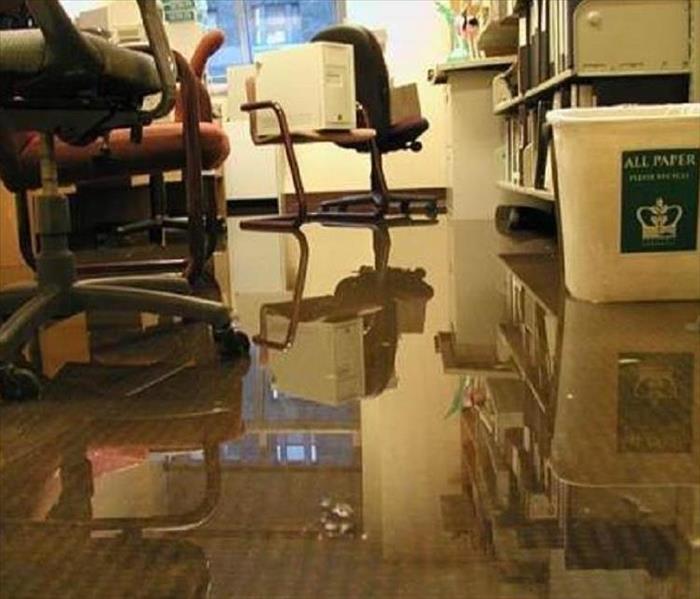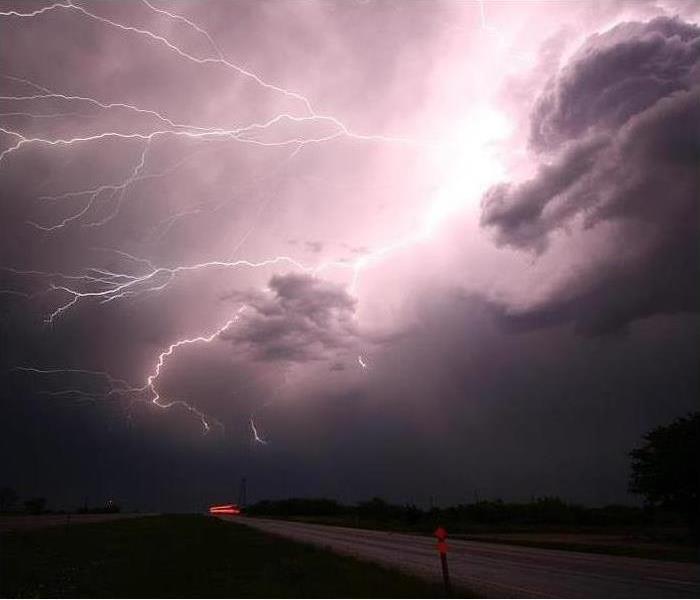Recent Storm Damage Posts
How to Prepare for Nasty Winter Weather
1/12/2023 (Permalink)
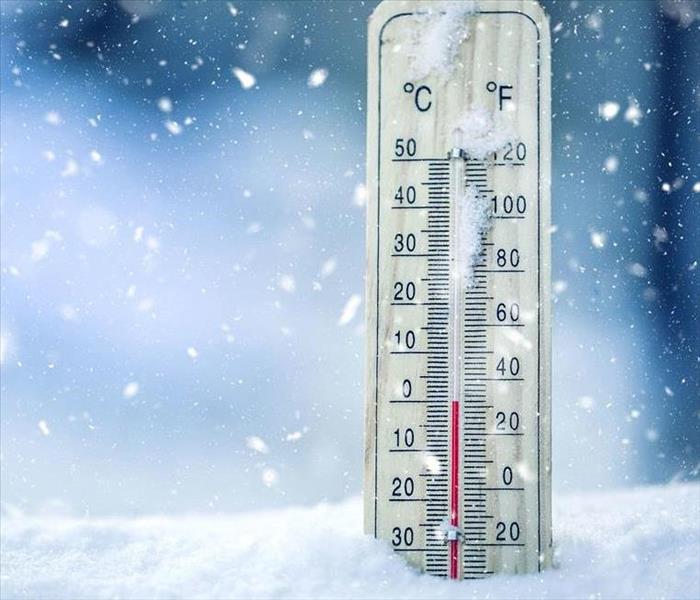 Winter weather in the Lehigh Valley can cause frozen pipes, ice dams, and puffbacks, leading to serious property damage.
Winter weather in the Lehigh Valley can cause frozen pipes, ice dams, and puffbacks, leading to serious property damage.
Winter Weather in the Lehigh Valley Can Catch You Off Guard and Cause Serious Problems
Pennsylvania residents are far too familiar with the unpredictable, unexpected nature of winter weather in the area. One day the temperature could be 50 degrees and hope that spring will arrive soon is strong. Then a massive, unexpected winter storm can arrive, leaving a large trail of disaster behind it.
Frozen pipes, puffbacks, and ice dams can all cause serious damage to your residential or commercial property. SERVPRO of Easton, Bethlehem, and Whitehall has professional advice for preparing your home or business for winter storms.
Preparing Your Home for Winter Weather
- Open cabinet doors during cold spells to allow warm air to circulate around pipes.
- Maintain a slow trickle of water flowing from faucets, especially if these pipes run through unheated areas of your home.
- To reduce the risk of puffbacks, ensure routine, proper maintenance of your furnace.
- Avoid ice dams and water damage by making sure gutters are clean of leaves and debris and secure to withstand winter weather.
Preparing Your Business for Winter Weather
- Inspect all stairwells, handrails, and entryways to identify potential slippery and hazardous locations.
- Ensure proper drainage to alleviate the potential of flood damage by inspecting property areas like walkways and parking lots.
- Check your commercial property for fallen tree limbs and branches. Winter weather like wind, snow, heavy rain, and ice can cause branches to fall, leading to potentially serious property or personal injuries.
- Contact SERVPRO of Easton, Bethlehem, and Whitehall to start an Emergency Ready Profile for your business.
When Winter Weather Strikes... Strike Back with SERVPRO of Easton, Bethlehem, and Whitehall.
How Homes Are Affected By Flood Damage
8/5/2022 (Permalink)
Blog Summary: An article by SERVPRO of Easton, Bethlehem, and Whitehall on the effects of flood damage on homes.
Floods may seem less catastrophic than other disasters like earthquakes or fires. But though not always immediately water can rise with serious and devastating consequences. Apart from water damage, flooding can result in electrical fires and electrocution accidents.
Flood damage can be extensive and restoration and cleanup are time-consuming. Flood damage restoration can be expensive. It can also be difficult to access when floods affect vital infrastructure and many large areas are affected. SERVPRO of Easton, Bethlehem, and Whitehall is quick to respond and has resources like trained personnel and specialized equipment to handle flood damage restoration needs. This company operates in local communities including in Quakertown, PA. In this article SERVPRO of Easton, Bethlehem, and Whitehalloutlines how homes can be affected by flood damage.
Floods are caused by water from a natural disaster like a hurricane or heavy rain. Homeowners must be able to differentiate flood damage from water damage. They must also be aware that they need a separate insurance policy to cover flood damage, especially if the area is prone to floods. Flood damage is devastating.
The following are the effects of flood damage that need to be addressed by flood restoration services.
Structural Damage
The sheer force of water moving during a flood can damage the foundation, walls, and siding of a home. The longer water is left standing, the more the structural integrity of materials like wood and drywall is compromised. The foundation can develop cracks due to hydrostatic pressure from the water below the ground. The longer the level of groundwater is high, the more the potential for flood damage.
Electrical Damage
Floodwater is an excellent conductor of electricity. To avoid danger the utility company is to switch off the power. Using electrically insulated gear must be used when working in a flooded area. Floodwater is also capable of corroding electrical equipment. Even after they dry, electrical switches, receptacles, and breaker panels exposed to floodwater can cause arcing. Some electrical equipment may need to be replaced after flood damage.
Mold
Mold growth can easily occur after floods, and can appear 24 to 48 hours after floodwater recedes and the surfaces are exposed to air. Spores released by mold can lead to allergic reactions. It is best to get professionals for mold removal.
Damage to HVAC and home appliances
The components of electrical appliances and HVAC systems are easily corroded after exposure to floodwater. They can stop working or overheat or cause arcing when used. Appliances may need to be replaced after flood damage.
Plumbing and Septic System Problems
Leaking pipes and damaged plumbing systems can cause floods. Once immersed in floodwater, fixtures may be repaired after disassembling and disinfecting them. If plumbing systems are blocked by contaminants carried by flood water they need cleaning. Floods can cause high pressure in water and sewage pipes causing them to burst. Septic systems can sustain flood damage.
Economic Loss
Flood damage can be financially crippling. Flood restoration services can be expensive. In some cases, homes may be vacated and the occupants may need to find accommodation which adds to the costs. A company like SERVPRO of Easton, Bethlehem, and Whitehall helps clients manage the insurance paperwork and process for an easier claims process.
Emotional Damage
Anxiety, depression, and anger may follow after the trauma of a home being flooded. The emotions people feel can affect their relationships and functions. It may take time for people affected by floods to cope with their consequences.
Flood damage has many undesirable consequences. Homeowners must take steps to prevent flood damage to their homes. But once there has been a flood, a professional flood damage restoration service is the best bet to get the place to pre-damage condition. SERVPRO of Easton, Bethlehem, and Whitehall is an expert in fire and water clean-up and restoration. They have 24/7 emergency services, are strategically positioned to serve any size emergency, and trained personnel. In Quakertown, PA SERVPRO of Easton, Bethlehem, and Whitehall can be called on (610) 559-9380 for flood restoration work.
How To Prevent Flood Damage in Basements
4/26/2022 (Permalink)
Blog Summary: SERVPRO of Easton, Bethlehem, and Whitehall Explains How To Prevent Flooding And Flood Damage In Basements.
Flooding in homes can happen suddenly. Millions of homes across the US get flooded due to heavy rains, and the overflow from nearby water bodies results. However, many US homes get flooded from sources within them. Water damage can occur from failure in plumbing systems which can flood homes. Water damage can be destructive. It can have long-term effects on the property value and even the health of its occupants. Flood restoration services can be expensive too, depending on the extent of the damage.
SERVPRO of Easton, Bethlehem, and Whitehall provides restoration services after a fire, smoke, or water damage. This company has highly trained restoration technicians and is locally owned and operated. As trusted leaders in the property damage restoration industry, they have the training, equipment, and resources to handle a disaster of any size. They serve different local communities across Pennsylvania, including in Whitehall, PA. In this article, SERVPRO of Easton, Bethlehem, and Whitehall explain how to prevent flooding in basements.
What Causes Basement Flooding?
Heavy rains: Rainstorms can cause flooding in basements.
Leaks in Plumbing: Leaks in pipes, burst pipes, and faulty appliances can flood a basement.
Leaky Windows: Basement windows can go unnoticed and when not maintained, window wells can be filled with water that leaks into the basement.
Cracks In The Foundation: Temperature changes, settlement, and soil moisture levels can cause cracks in the foundation. Foundation cracks are a common cause of basement flooding.
Faulty Appliances: A water heater that crosses its lifespan is at risk of bursting. Burst water heaters can rapidly flood a basement. Washing machines can leak when they are faulty too.
How To Prevent Flooding in Basements
Gutter Maintenance: Gutters must be cleaned at least twice a year. Natural debris like twigs or leaves can block gutters and push rainwater down the siding and around the home. Water that pools can get into the basement through cracks in the foundation.
Extend Downspouts: Extending downspouts so that water is directed away from the house foundation helps direct water away from the house. Downspout extensions are available at local hardware stores and are easily installable.
Grading the Yard: If water pools around the home when it rains it indicates poor grading. Water must be channeled away from the home. A landscaper can help to grade the lawn away from the home.
Inspecting The Foundation For Cracks: Foundation cracks cause water to permeate the concrete. Inspecting the foundation a few times a year and sealing them can help prevent basement flooding.
Maintaining A Gap Between Mulch and Sliding: Having a gap of around 6 inches between flower beds and the wall of a house will help move water away from the building when there is a rainstorm.
Watering Lawns Properly: Overwatering lawns can lead to basement flooding problems. Only the recommended amount of water for the lawn and plants must be provided. Sprinklers must be placed so that they are clear of the house and must be programmed so that the lawn is not watered excessively.
Maintenance: The plumbing and appliances like heaters and washing machines must be checked and maintenance work done as needed. This will help prevent leaking and resulting flood damage to an extent.
Sump Pump Installation and Maintenance: Sump pumps must be installed and regular maintenance work done. They help to prevent large-scale flooding and are a good investment in areas prone to flooding.
Keep Windows Covered: Window well covers will help to protect basement windows from rainwater seeping into the basement through windows. Clear acrylic window covers will offer protection while keeping water out.
Have Power Backup: A backup generator will keep electricity, heat, pump, and septic tank operating in case of a power outage. When these don't operate the risk of the basement flooding rises.
All these steps will help to reduce the risk of flood damage. However, there can always be accidental causes that lead to flooding. Homeowners in flood-prone areas could take an insurance policy for flood damage after enquiring. Flood damage restoration is tedious and time-sensitive. A professional company will be helpful in providing flood damage restoration services. SERVPRO of Easton, Bethlehem, and Whitehall provides 24-hour emergency services and responds immediately to a flood or water damage. With highly trained water restoration technicians who provide advanced water inspection, extraction, and drying services, they are the best choice to handle flood damage. SERVPRO of Easton, Bethlehem, and Whitehall can be contacted at any time, on any day of the week for fire and water damage restoration services at (610) 559-9380.
How To Identify Signs of Roof Damage After A Storm
3/1/2022 (Permalink)
Blog Summary: How homeowners can check for damage to roofs after a storm is shared by property damage repair experts, SERVPRO of Easton, Bethlehem, and Whitehall.
Storms can be very destructive. There are different types of storms like blizzards, hailstorms, thunderstorms, tornadoes, hurricanes, derecho storms, etc. They can cause property damage incurring costs depending on the severity of storms and the extent of the damage.
Types of Damages Caused by Storms
- Wind Damage
Strong winds can weaken and compromise roofs, especially over time.
- Hail Damage
Hail storms can penetrate shingles or wooden shakes leading to leaks, and water damage.
- Water Damage
Exposure to water can result in water damage from the roof to the foundation of a building. It compromises the structural integrity of a house and can lead to mold formation.
- Impact Damage
Latent damage that occurs over time and is not always immediately noticeable is impact damage. It causes premature aging of the structure.
Damage to the roof is common after storms. SERVPRO of Easton, Bethlehem, and Whitehall shares some signs of storm damage to a roof. Identifying damage and promptly performing storm damage restoration is important to minimize the extent of damage and the cost of repair.
Signs of Roof Damage
Homeowners must wait until the storm has passed and it is safe to check the roof from outside. Attempting to walk on the roof is too dangerous and should be avoided. Instead, the following signs can be checked for.
- Leaks or signs of water damage in the attic indicate a leaking roof.
- The yard and house exterior must be checked for fallen tree limbs, missing parts of a fence, damage to outdoor furniture, and signs of hail damage to flat surfaces like patios and decks which can indicate a probability of storm damage to the roof. Shingle or metal pieces from the flashing of the roof on the premises show that the roof has sustained damage.
- Cracked windows and dents on home gutters and roofing accessories like gable vents, may indicate the roof has been damaged.
- The roof can be checked from the ground while walking around the house or from windows of the house that give a good view of different parts of the roof. Noting down and taking pictures of signs of storm damage like dents or missing shingles. This can help in documentation and may help in the insurance claim process.
- Signs of Wind Damage
Missing shingles, shingles that are missing granules after a storm, cracks or tears in rubber roofing, damage to the chimney, like missing bricks, a leaning chimney, damaged or missing chimney cap, leaks after wind that was accompanied by rain are all signs of roof damage.
- Signs of Hail Damage
Pockmarks on the shingles of the roof, areas of missing granules on roof shingles, round ball-like indentations on the exteriors of the home.
- Signs of Damage by Debris
Debris like tree branches on the roof, cracked or missing shingles, missing granules on shingles, or a big pile of shingle granules at the bottom of a downspout after a storm.
After the initial inspection of damage (further inspection can be done by a professional), and documenting signs of damage noticed, a storm damage restoration specialist can be approached. The insurance provider must be contacted.
A property damage repair company like SERVPRO Easton, Bethlehem, and Whitehall can provide all restoration services needed after storm damage. Commercial and residential property can sustain storm damage that needs water damage cleanup and restoration, mold remediation, and structural repairs including repair or restoration to the roof. All these services may be provided by SERVPRO Easton, Bethlehem, and Whitehall which is a trusted leader in the water restoration industry. They can be contacted on (610) 559-9380 for fast service by a team of highly trained water restoration technicians for disasters of any size.
What To Do Before Storm Damage Restoration Begins
1/12/2022 (Permalink)
Blog Summary: SERVPRO of Easton, Bethlehem and Whitehall outlines types of storms, potential damages, and what to do before professional damage restoration begins.
Different parts of the country are prone to storms. Storms are a leading cause of water damage and can lead to other structural damages as well, depending on the type and intensity of the storm. Some common types of storms include:
- Hail Storms
- Thunderstorms
- Ice storms
- Tornadoes
- Blizzards
- Floods
- Hurricanes
People residing in storm-prone areas are usually prepared for the types of storms that are prevalent there. But there are instances of storms occurring in other areas too, or at odd times. Irrespective of when and where they occur storms are devastating when they cause damage. Storm damage can be limited or very extensive depending on the intensity. It can include water damage, mold, structural damage to roofs, flooring, and walls, electrical damages that can cause fire damage, etc. Minimal damage may be manageable by the homeowner. When there is more damage a professional storm damage restoration service is the way to go. Here are some things to do after a storm to ensure safety until the property restoration and cleanup company arrives.
Homeowners need to make sure that it is safe to step out. Get information from reliable sources like disaster relief personnel or local radio stations. Homeowners must retrieve only important documents or valuables if leaving the home is necessary for safety. If reentering a flooded home, a homeowner must take safety precautions.
Contact Insurance Company
If the home insurance covers storm damage they should be contacted. It would be good to document all damages by taking pictures. This is helpful for the insurance company and storm damage restoration company.
Check if Water Inflow Can be Stopped
While stormwater is impossible to stop. Homeowners can try to divert water from the house by blocking or damming the water run and by ditching, if permitted. Flooding by freezing pipe bursts and such need professional help, but the water supply can be turned off to minimize water damage if possible.
Precautions to Avoid Electrical Dangers
Electrical appliances exposed to water can be disconnected if possible to do safely. They may need servicing. Frayed and damaged wires must be steered clear of. Any structural damage or damaged, exposed wires will need the services of an electrician. If the power can be switched off from a dry place it can be done. Otherwise, the electrician should do so. The utility company must be alerted if there are tree branches or other debris fallen on the power lines nearby.
The roof can be inspected and any possible temporary fix that prevents rain from coming in and minimizes water damage can be done, if safe. But eventually, this might be part of the damage restoration service needed.
Pipes can be checked for visible damages. Ice storms and blizzards can cause freezing pipes to burst. In that case, the water taps to toilets and sinks need to be turned off, and if necessary all water to the home may need to be turned off. Sewage backing up in toilets or sinks is a severe problem that needs expert help. If so, all sinks and toilets must not be used.
If there is no electrical or other danger, homeowners can try to remove standing water as far as possible with a squeegee or pump. Carpets, drapes, furniture, etc can be removed to drier places if possible, to reduce mold damage. Ultimately extensive cleanup and water damage restoration would be needed from a professional property damage company with relevant expertise.
It is always best to get professional help as storm damage can be vast, difficult to detect, and has implications on safety. It needs specialized equipment like pumps, air movers, and dehumidifiers. They also use technology to detect trapped residual water and moisture. SERVPRO of Easton, Bethlehem and Whitehall is a leader in storm and water damage restoration. With highly trained specialized technicians and scientific drying techniques, progress monitoring, and documentation they are the best choice. With resources from 1,700 franchises across the state and country, SERVPRO of Easton, Bethlehem and Whitehall can handle projects even during major storms and floods. They are a locally owned company with a national presence that can be contacted on (610) 559-9380 for any flooding or storm emergency at any time.
Tips for Choosing Flood Water Restoration Service in Whitehall, PA
12/20/2021 (Permalink)
Blog Summary: This article explains the tips clients can use to find reliable flood water restoration services in Whitehall, PA.
In Whitehall, PA, Flood damage resulting from natural disasters can be destructive. When that happens, you need to have a flood restoration strategy to fix the damages and make your home livable once again. Doing all this by yourself can be taxing. You will need to find a flood restoration service provider to assist you. Use these tips to select a reliable flood restoration service in Whitehall, PA.
Quick Response Time
Water disasters usually happen when you least expect them to occur, and you need to fix them immediately to avoid further damage to your property. Your flood restoration service provider should be able to respond to your call on time. Hire a company that offers 24-hour service and can quickly respond to emergencies. The company should also start the cleaning and repair processes within the shortest time possible.
Licensed and Insured
As you search for a trusted and reliable water damage restoration company, find one that is insured and has all the licenses needed in Whitehall, PA. Check the skills of the company employees and find out how many years the company has been in operation.
Provides Detailed Plans for Flood Restoration and Damage Repair
Restoring your home to its former habitable state requires proper planning from professional flood restoration services. The plan should be detailed and expansive to accommodate repairs and prevention of possible future issues such as mold growth. You should determine if a water damage restoration company can provide a plan with cost estimates before hiring them to work on your home. In addition, a qualified flood restoration company will assess the extent of flood damage to your home, recommend the repairs that need to be done, and offer dependable cost estimates for you to make an informed decision.
Equipment and Expertise
Flood restoration services involve water removal, dehumidification, and drying your home to prevent mold formation. You need to find an experienced company with the right equipment for this job. Companies using the latest technology are likely to quickly complete restoring your home, ensuring your personal effects such as photographs, documents, and artwork are well-catered for and protected.
Familiar with Insurance Claim Process
Most homeowners experience challenges when filing a successful insurance claim after water damage. Therefore, it is prudent to look for a flood restoration company that will assist you in documenting flood damage and file timely, genuine, and well-documented insurance claims.
Professionalism
Water damage is stressful and frustrating. You will need to find a reliable and trustworthy flood restoration service provider like SERVPRO of Easton, Bethlehem and Whitehall to take care of your home in the event of water damage. A company with a high level of professionalism will help resolve this problem and restore your life to normalcy. They should provide safe on-site storage of your personal effects while your home is being restored, and assist with filing insurance claims to ensure you return to the pre-flooding state in the shortest time possible.
Reputation
Find a flood restoration company with a good reputation. Seek recommendations from neighbors and friends. Read local review sites that offer credible customer feedback on water damage restoration services in Whitehall, PA.
SERVPRO of Easton, Bethlehem and Whitehall is an experienced and trusted flood restoration service in Whitehall, PA. The company is reliable and responsive. To contact them for water or storm damage restoration service, call (610) 559-9380 or send them an email at SERVPRO5770@SERVPROofeaston.com or visit the company's offices at Allentown, PA 18109.
Tips for Developing a Business Continuity Plan
11/18/2021 (Permalink)
 Outline a business continuity plan with these tips and put your mind at ease.
Outline a business continuity plan with these tips and put your mind at ease.
Suggestions for Creating a Business Continuity Plan
If you own a business in Mt Bethel, PA, it’s bound to face an event that temporarily interrupts standard operations. Be it a hurricane, flooding, snowstorm or something else, a disaster can have dire consequences for your business if you’re not prepared. A sound business continuity plan can help, outlining the resources needed to keep your business operational during a crisis. Here are a few tips that will help you create a plan that will give you peace of mind.
Form a Business Continuity Team
During a crisis, your business will need multiple staffers, so more than one employee should be involved in preparing for an emergency. Gather a team comprising your most responsible, trustworthy staffers to plan for the worst. They’ll focus on things like measuring potential business impact and determining the resources needed to keep things up and running.
Develop a Plan
Talking about a plan is usually easier than developing one, but with a few steps, you can handle it with ease. Make sure to focus on some essential aspects of plan development:
- Identifying the scope of the continuity plan
- Identifying critical business functions and their interdependencies
- Defining acceptable downtimes
- Agreeing on the circumstance and methods of plan implementation
A checklist can be handy for making your continuity outline. Include major pieces, such as the location of critical data backups, as well as simple things, such as where basic supplies are kept in the building.
Train Your Employees
Your plan is only as good as its implementation, so familiarize your employees with it. Scenario-based emergency-response training is a great option that can provide insights you can use to tweak your plan.
It’s often not a matter of whether disaster will strike your business, but when. Don’t wait until you face flooding or storm damage to think about disaster response. Outline a business continuity plan with these tips and put your mind at ease.
The Importance of Wind Mitigation Services for Your Commercial Property
8/10/2021 (Permalink)
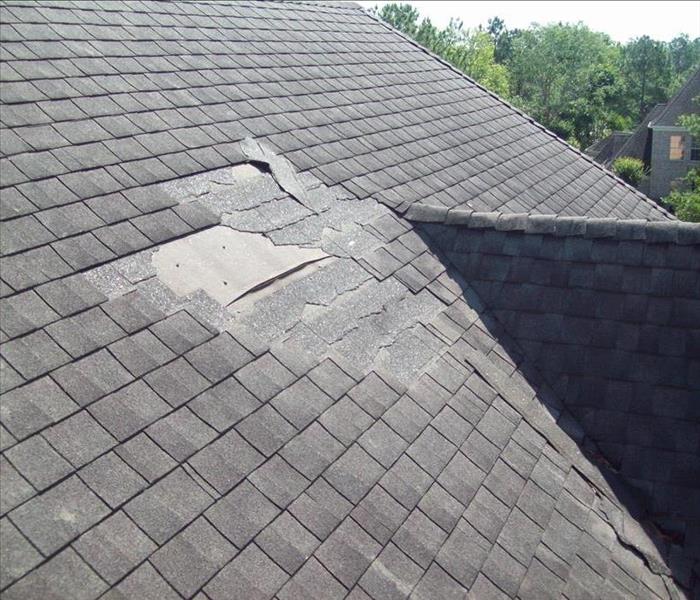 High winds can cause roofing issues.
High winds can cause roofing issues.
Wind Mitigation Services: How Important Are They for Your Commercial Property?
When the wind starts to howl in Easton, PA, it can cause serious damage to your commercial property. Your building’s roof might be the most vulnerable to strong winds, as it can tear away shingles, weaken building materials and even result in a roof leak that can cause further damage to the interior of your business. However, understanding the importance of storm mitigation can prevent a loss of inventory or a prolonged closure when high winds impact your building.
Wind Can Cause Sudden Damage
A professional storm and mitigation and restoration company can be an asset when high winds cause unexpected damage to your commercial building. Missing shingles, torn tar paper and loose gutters can all occur during a windstorm, and having a company on hand that can temporarily fix these issues until permanent repairs can be made might prevent the damage from spreading or causing a chain reaction of other serious issues.
Professional Intervention Saves Time and Reduces Stress
Whether a windstorm causes a sudden roof leak or tears away a section of shingles, having a mitigation team on standby can give you peace of mind that you will be able to call for help right away. These professionals will likely arrive with materials like heavy tarps and plywood to cover the damaged sections of the roof until further repairs can be made. Even temporary repairs can lower the risk of further damage that can both costly and stressful.
Mitigation Can Help You Plan for Future Emergencies
A damaged roof needs immediate attention and retaining a restoration company that offers storm mitigation services can be part of your emergency weather plan. Mitigation can protect your employees and customers from being struck by flying roof debris and secure the damage until it can be repaired. Being well prepared for weather emergencies can reduce the risk of accidents and injuries that may result in costly litigation.
Whether high winds in Easton, PA, cause a roof leak or other roofing issues, mitigation can resolve them quickly. This can protect your investment and give you peace of mind as a business owner.
Best Ways to Prepare for Flood Damage
7/26/2021 (Permalink)
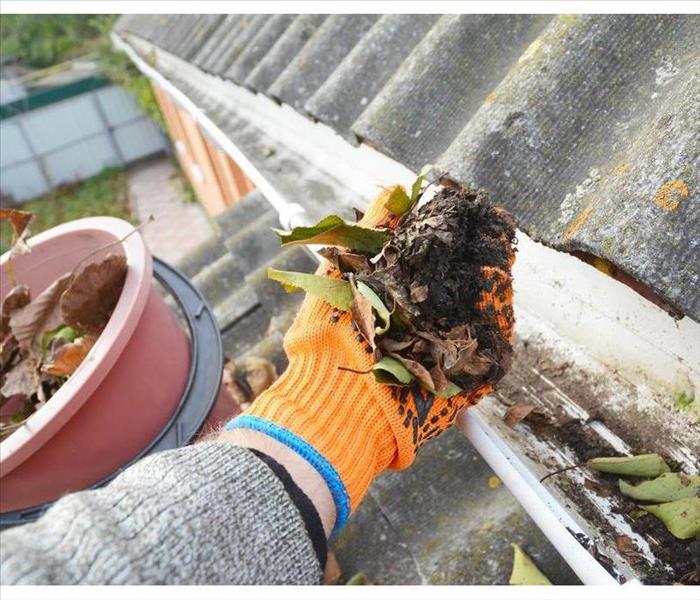 Clean gutters regularly.
Clean gutters regularly.
The Best Flood Damage Preparation Methods
Depending on where you live in Bethlehem, PA, your home may stand in a flood zone. If flooding is a strong possibility in your area, it’s critical that you take the proper precautions so you can mitigate damage to your home and personal property. You may not be able to completely stop water from getting into your house, but you can minimize its harmful effects.
Assemble an Emergency Kit
If you wait to start preparing for a flood once the rain starts falling or once the water begins creeping into your house, it’s too late. You need to get ready today with the proper materials to help ensure your safety and well-being from flood damage. Include these items:
- Non-perishable food
- First aid kit
- Extra batteries
- Flashlight
- Toiletries and hygiene items
Clean Your Rain Gutters
If a major rainstorm hits your area, the storm damage can be severe, especially if your rain gutters aren’t diverting water from your home. Make sure you remove leaves, dirt and other debris from your rain gutters. If you fail to do this, water could pool up near your foundation which could then find its way into your home.
Clean Your Storm Drains
Other problem areas when it comes to flooding are the storm drains in front of your home. If these are cluttered with garbage and other materials, you could be in trouble if a large storm rolls through your area. It’s vital that you clean out these gutters, so they don’t overflow and put your home in danger. If you don’t have the equipment and expertise to handle this task on your own, you can contact an experienced company that specializes in this type of maintenance.
You can’t always predict when flooding will affect you and your home, but you can prepare yourself. Follow these tips, and you can have peace of mind that you’re doing all you can to ensure your safety.
What Is Category 3 Water Damage?
5/12/2021 (Permalink)
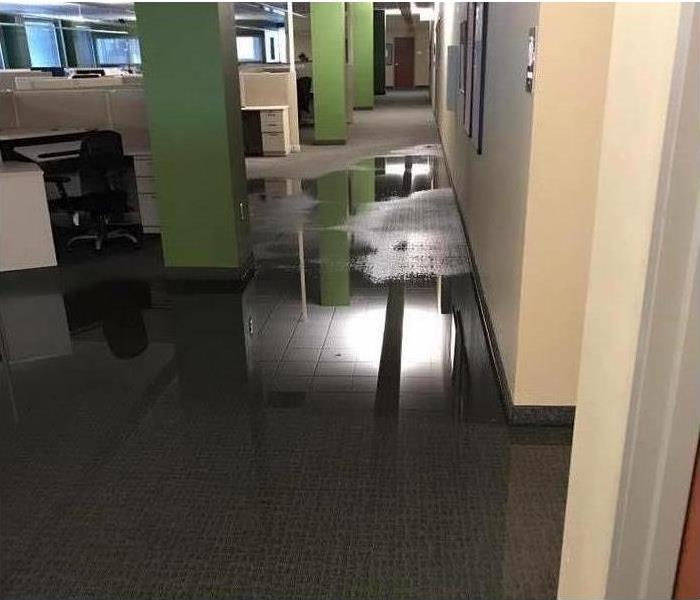 Commercial water damage in Mt Bethel, PA.
Commercial water damage in Mt Bethel, PA.
If your commercial property in Mt Bethel, PA, has been affected by a flood or other water issue, chances are you are dealing with some level of water damage to your building. Depending on the type of water issue you have had, you may be dealing with category 1, 2 or 3 water damage. If you have category 3, the most severe type, there are a few things to know to help you clear it out quickly and safely.
What Is Category 3 Water?
Category 3, or black water, is the most contaminated level of water damage. lt is highly contaminated with bacter and microorganisms and can come from many places, such as:
- A sewage problem, such as a backed up toilet, sink or shower drains
- Burst pipes
- Standing water from a natural disaster, such as a flood
What To Do If You Find Black Water
If you have a sewage problem or water damage from a flood, you should call in a professional water restoration company to help you deal with the aftermath, as there is a chance you have black water. Although it is safe to try to remove water if it is clean water, black water should only be cleaned by professionals who are wearing the proper personal protective equipment. Keep yourself and any building residents away from the source of the water damage until help arrives.
How To Restore Your Building
A restoration company will help you begin the restoration process for your commercial building. Any items inside your building that have been affected by the water damage or may have absorbed the water may have to be replaced. Ensure that everything has been sanitized and cleaned before building residents return.
If your commercial building has been affected by water damage, it's important to identify the category of water damage your building has been impacted by. Calling in a restoration company. quickly can help you get back to normal as soon as possible.
3 Reasons To Buy Flood Insurance
4/12/2021 (Permalink)
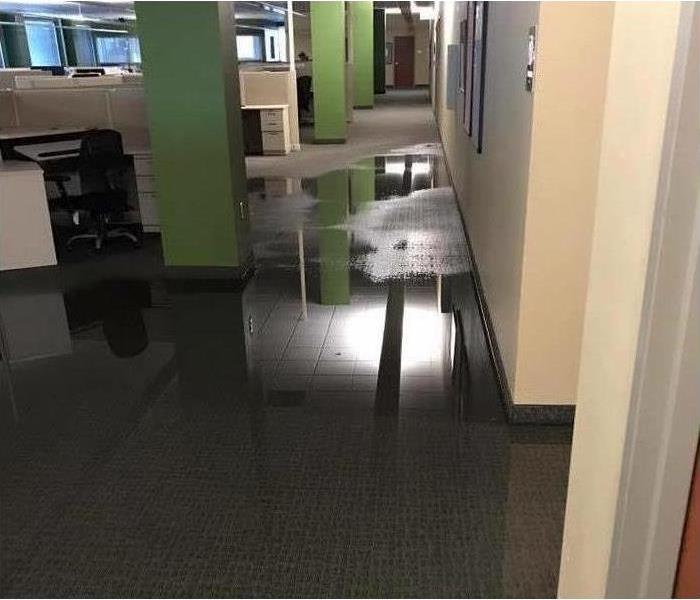 Office storm damage in Pen Argyl, PA.
Office storm damage in Pen Argyl, PA.
Why Purchase Flood Insurance?
Even though it is not required, a flood policy is a good idea for business owners in Pen Argyl, PA. You can get good policies through both the government and private companies. If you're on the fence about this type of coverage, here are some reasons you should purchase it.
1. It Is Affordable
Floods can do serious damage to any business. When you tally up the damage done and the cost of hiring a storm restoration company to fix it, floods are very costly. Unfortunately, this is not covered by standard commercial insurance. Considering the amount you would have to pay to fix flood damage, the cost of having a special policy doesn't seem too expensive. Plus, most businesses can get a policy for less than they expect. This is especially true when you can add flood coverage to your standard property insurance.
2. Every Property Is at Risk
The property maps created by the Federal Emergency Management Agency are an estimate of where flooding will occur based on past conditions. However, even low-risk zones still have a decent chance of flooding. Instead of marking you as safe from a flood, placing your business in a low-risk zone lets you add flood coverage to your commercial insurance for less.
3. Flood Damage Is Catastrophic
Flooding is a common side effect of many natural disasters and storms. In fact, it results in billions of dollars of damage each year. Your business alone could end up with thousands of dollars in repairs that are not covered under a standard commercial insurance policy.
Flooding is a common issue that can do serious damage. The results of this disaster are costly to repair. Even though the FEMA maps mark some areas as low-risk, this does not mean businesses in these regions are clear of flooding. Therefore, flood insurance is a good idea for any business owner.
4 Tips for Protecting Your Home From a Flood
1/12/2021 (Permalink)
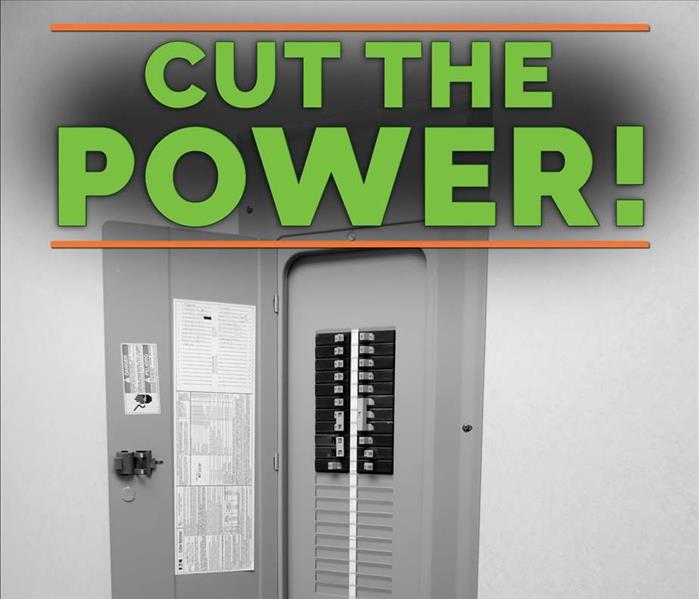 Shut off electricity at your breaker panel
Shut off electricity at your breaker panel
Measures To Take To Increase Flood Safety
Flooding causes billions of dollars in damage to homes and other property every year in the United States. It is not practical to flood-proof your home; however, there are measures you can enact to increase flood safety and reduce flood damage.
1. Locate Electrical Equipment Above Flood Level
Wiring, circuit breakers, switches, and sockets should be installed at least one foot higher than the expected flood level in your area. If your water heater, furnace, or other anchored indoor equipment is not already above the flood level, modify it so that it is.
2. Don't Forget Last Minute Measures
Some flood safety steps should be taken far in advance, but there are still steps you can take when flooding is imminent. Clean debris out of your gutters and downspouts. Shut off electricity at your breaker panel. Place major appliances on concrete blocks. Move furniture, electronics, rugs, and other valuable contents to the top floor of your home. If your belongings get wet, consider contacting a flood restoration company in Stockertown, PA, to clean and dry them.
3. Elevate and Anchor Outdoor Equipment
Fuel tanks, generators, and air-conditioning units located below the flood level outdoors can break free causing ground contamination. Elevate these items above the flood level and anchor them so they can not easily be swept away.
4. Modify Your Landscaping
Observe how water flows around your house during a rainstorm. If it is collecting in areas near your home, it can be helpful to modify your landscaping to direct water away from your home. Consider adding features such as swales or rain gardens. If your yard doesn't slope away from your home, you may need to have it graded. Add native plants that increase drainage.
Having a flood safety plan is critical for protecting your family and your home from flood hazards. These four safety tips can help you prepare for a flood situation in your home.
Don’t Let a Power Outage Halt Your Business
11/16/2020 (Permalink)
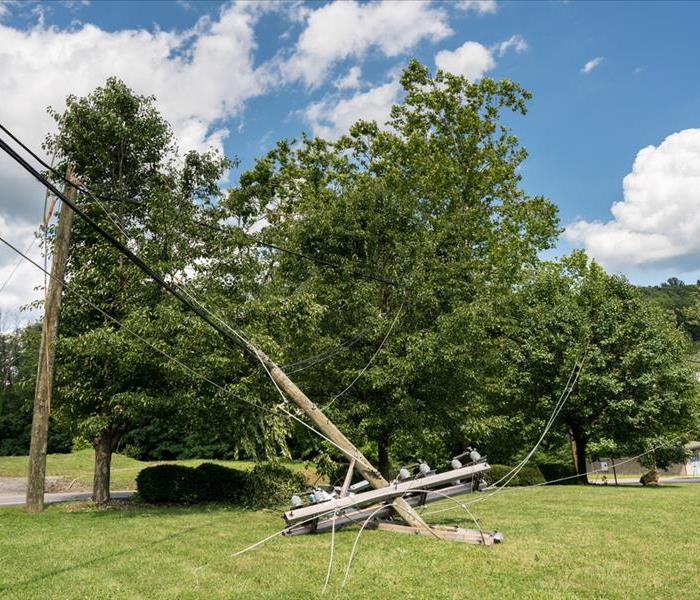 An unexpected power outage could potentially result in devastating consequences
An unexpected power outage could potentially result in devastating consequences
What To Do If There's An Unexpected Power Outage?
Your business might typically run like a well-oiled machine, but what happens if the power goes out? An unexpected power outage could potentially result in devastating consequences like losing important documents, hardware or income, in general. Prepare your business well in advance to keep operations running as smoothly as possible.
1. Cloud Backup
An automatic cloud backup solution can protect essential files, whether there’s a power surge, outage or a computer malfunction. By choosing an automated backup solution, you don’t have to remember to back up; you can set it to perform backups multiple times each day. If anything happens, you’re easily able to recover valuable information you could’ve otherwise lost.
2. Generator
A commercial standby generator is an excellent option for defeating an electrical interruption, especially if it’s for an extended time. You could also get a portable generator. Your business needs to keep running as normal as possible. A generator will allow that to happen. Generators are usually powered by propane or natural gas. They can immediately switch on automatically when your power goes out. Generators can be pricey, but they can prove to be well worth the investment in the long run.
3. Computer Backup Battery
Storm damage can often cause an unexpected power outage that can potentially last for days. You can still keep at least your most essential business operations running until its return. It may not be ideal, but getting a backup battery for your computer(s) is a good solution for keeping things going until restoration professionals arrive on the scene.
4. Mobile Hotspot
Setting a mobile hotspot will allow you to connect multiple devices to the internet via your cellular network. It may not be as fast as your office internet, but it’ll be a good option until the internet returns.
Prepare your Wind Gap, PA, workplace as much as possible before a power outage occurs. It could mean the difference between continuing company operations or losing valuable business.
What To Know About Flood Zones
10/20/2020 (Permalink)
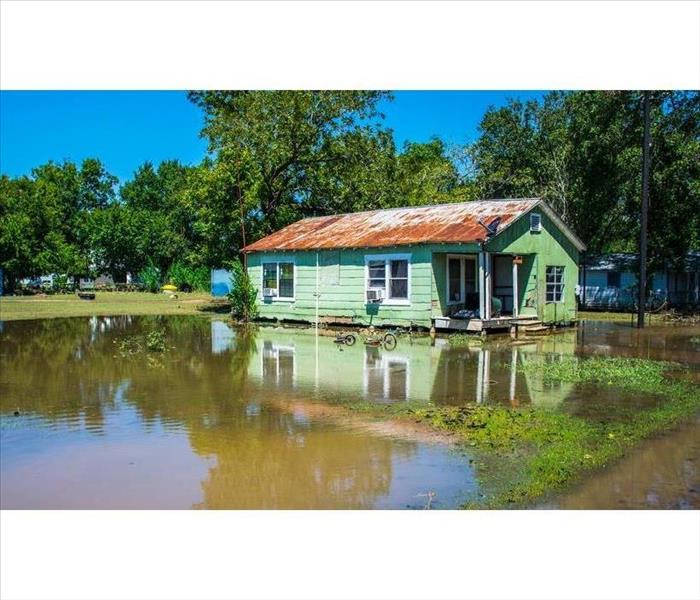 Understanding your house's flood zone can help you prepare for the harm caused by heavy rainstorms
Understanding your house's flood zone can help you prepare for the harm caused by heavy rainstorms
What To Know About Flood Zones
Some places are more prone to flooding than others are. To find out whether your Stockertown, PA, home is at risk, you need to determine its flood zone. Flood zones designate which properties are most likely to flood during a major storm.
The Federal Emergency Management Agency has created a Flood Map Service Center that lets you research flood zones. Simply click on this link to get:
- Your local flood map
- The accompanying Flood Insurance Study Report
- Other mapping products
The FEMA website also lets you create a customized flood map that you can save on your computer. Simply type in your city or even your specific address.
Changing Flood Zones
FEMA calculates a home's flood zone by looking at various details of the property and its elevation. If you believe your house was wrongly classified, you can send a Letter of Map Change to the agency. The later can be submitted online or via regular mail.
Protecting Your Home
Even those who live in low-risk areas need to prepare for possible floods. After all, water damage to your home can still occur no matter where you live.
Start by purchasing flood insurance. Your homeowners' policy likely does not include flood coverage, but you can get a separate flood policy from the federal government.
You should also have a flood preparation plan in place. Make sure that you and your family know where to go and what to do if the water level starts to rise. Gather supplies and store them in a safe place that you can quickly access in an emergency.
Finally, research the contact information for your local water damage repair company. You may need to call restoration experts if your home sustains severe flooding.
Understanding your house's flood zone can help you prepare for the harm caused by heavy rainstorms. Still, even if you live in a low-risk zone, you should take steps to secure your property.
Bags of Sand Are No Longer the Kings of Flood Prevention
9/14/2020 (Permalink)
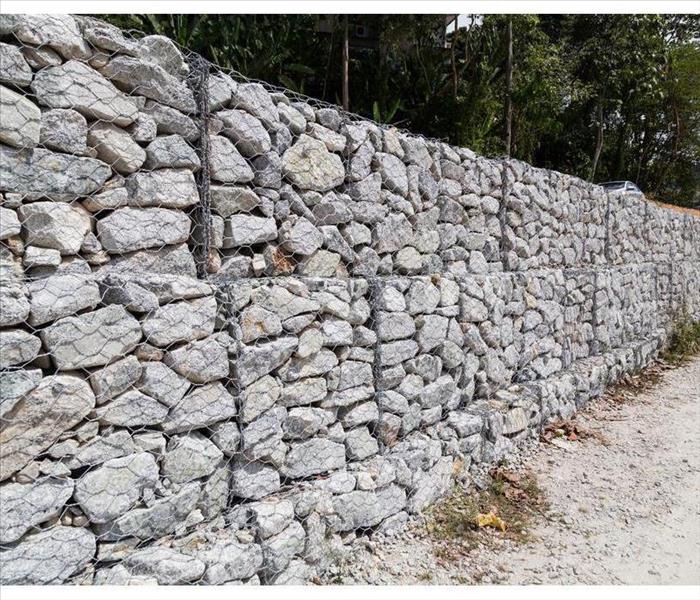 Flood wall alternatives for your facility
Flood wall alternatives for your facility
Those tasked with keeping their companies safe from flooding often assume the Sand Bag method is their only reasonable recourse. While this option may seem appealing, modern devices currently available in Bethel, PA, have the potential for being vastly superior.
Disadvantages of Sand Bags
Using bags of sand as flood prevention comes with numerous drawbacks, including:
Building time. When storms strike, will you be able to erect a wall quickly enough?
Manpower. How many able-bodied employees exist at your disposal to effectively get the job done?
Removal. Once your border protects you from flood damage even once, it becomes a damp, useless mess. Does periodic rebuilding seem an appealing proposition?
Low reliability. Any Sand Bag wall is prone to collapse. Can you imagine needing a commercial water damage cleanup specialist after all that effort?
Also, bags filled with sand can be deceptively expensive, owing to their regular need for replacement. The long-term cost of this approach could well exceed that of other protection solutions.
Flood Wall Alternatives
Businesses are no longer limited to old-fashioned flood dams.
One contemporaneous choice is Watershed Innovations’ HydraBarrier, which utilizes a hose to spray a six- or twenty-inch defensive barricade, depending on height needed and your budget. It fills in less than two minutes and is conveniently reusable after draining.
The AquaDam goes even higher, rising a full three feet. Note, there remains a risk of it washing away should floods exceed this height. On the plus side, the setup is exceedingly efficient.
The AquaFence is more costly but erects an impressive four-foot barrier that extends the length of a city block. In addition to elementary installation, it’s constructed with an aluminum canvas that reinforces sturdiness.
New technology means the Sand Bag technique is no longer your only path for flood prevention. Maximize the time and money you spend protecting your office by making use of a scientifically advanced safeguard.
3 Ways To Protect Your Home With Landscaping
8/11/2020 (Permalink)
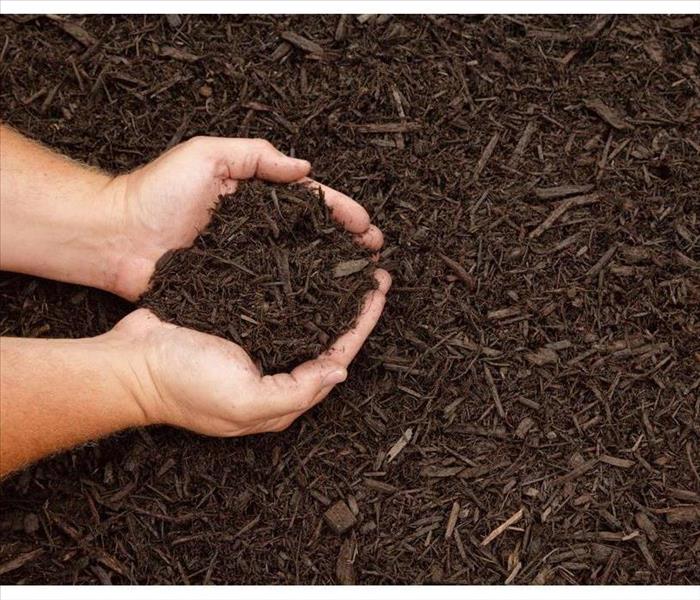 Opt for heavier mulches instead
Opt for heavier mulches instead
Ways To Protect Your Home From Flood Damage
Outside flooding in Wind Gap, PA, can wash out flower beds, eat away at landscaping, and damage lawns. Fortunately, there are techniques that landscapers often use to divert the flow of rainwater and reduce the chance of flooding. Here are three solutions you can implement to help protect your property from flood damage.
1. Use Heavy Mulch
Light mulch, like that made from pine, tends to be lightweight and can easily be carried away during a heavy rain storm. Opt for heavier mulches instead. Certain kinds of hardwood mulches and manmade mulches can weather all but the heaviest storms.
2. Plant a Rain Garden
Rain gardens are used to give the water a place to pool, which can significantly reduce the amount of outside flooding you experience during a storm. When done well, rain gardens can add an attractive feature to your landscape. If you use native plants, the garden will require little maintenance once it is established. Rain drainage occurs around the edges first, leaving the middle of the garden wet the longest. Take advantage of this scenario by placing the plants that are the most moisture-tolerant in the middle of the garden.
3. Divert Rain Spouts
Rain spouts are used to direct the water as it rolls down your gutters and off your home. Use rain spouts that are at least three feet long. Make sure the water follows a desirable, downward path after it leaves the rain spout. Otherwise, it could return and pool around the foundation of your home. If you live in areas with sandy soil, you may need a longer rain spout.
As a homeowner, you want to protect your property from outside flooding. Although the techniques listed above can go a long way in protecting your home, water damage can still happen. If you have experienced water damage, a professional restoration service can get your home back to normal as quickly as possible.
2020 Already Blows… Now Bring on the Hurricanes
6/18/2020 (Permalink)
The 2020 hurricane season is predicted to be more active than previous years have been. According to the NOAA’s Climate Prediction Center, this year will bring a likely 13 to 19 “named storms” - these are storms with winds of 39 mph or higher. Of these, 6 to 10 could become hurricanes - storms with winds of 74 mph or higher. And 3 to 6 of these could become major hurricanes of winds 111 mph or higher. To put this in perspective, an average season brings 12 named storms, 6 of which become hurricanes, and 3 of which are major.
It’s important to be properly prepared before these hurricanes hit to help prevent damage or loss to your property.
Important Supplies
- Family Emergency Readiness Plan
- Three days worth of water
- Three days worth of non-perishable food for each person or pet
- First Aid Kit
- Battery powered radio or radio alert
- Portable power bank to charge cell phones
- Full tank of gas in car
- Batteries
How To Prepare Your Home
- Cover your windows with storm shutter or plywood, or at least tape the glass so any broken shards will stay together
- Find out if you live in an area that floods, and learn how to properly sandbag your home
- Keep your rain gutters cleaned out as often as possible
If your property experiences flooding or storm damage, please reach out to SERVPRO of Easton, Bethlehem & Whitehall to help with your clean-up and restoration needs.
Give us a call today… 800-455-9453
The Four Steps of Filing a Flood Claim
4/28/2020 (Permalink)
 There are steps you should take to file a flood claim when your home has suffered damage
There are steps you should take to file a flood claim when your home has suffered damage
There are Steps To Take To Filing a Flood Claim
Homeowners often have the responsibility to carry flood insurance, especially if they live within a flood zone. For some of these homeowners, federal coverage is available. As a homeowner in Coffeetown, PA, you may have insurance through a local provider. Whatever your situation is, there are steps you should take to file a flood claim when your home has suffered damage:
Report Damage to Your Insurance Provider
Your prompt action is necessary, especially because some policies are only effective for a certain amount of time after damages occur. Contact the insurance provider who sold you the policy as soon as you can.
Document the Damages
In the past, a written record may have been sufficient, but today, it's best to take photographic evidence of damages. After you've taken pictures, it's okay to move water-logged and damaged items outside, but don't throw anything away until an adjuster has made an assessment of damages.
Work With the Adjuster
After you notify your insurance provider and begin the insurance claim process, an adjuster will contact you. The adjuster will provide official identification, and you will provide your insurance policy number, estimates from contractors and water damage repair professionals, receipts, and other pertinent information. The adjuster will take more measurements and photos, provide you with a local contact, give you a flood certification number, and prepare a proof of loss statement.
Follow Through
After you receive the proof of loss form, you have just 60 days to sign the form and return it. At this point, there are a few scenarios to expect. If you approve of the amount, you can wait for a check. If you disagree, you'll need to arrange for an independent appraisal. If your insurance claim was denied, you can make an appeal to FEMA.
In most cases, these four steps will help you satisfactorily file a flood claim. The more you know about your insurance policies before a disaster, the better prepared you'll be when major storms hit.
3 Tips To Protect a Commercial Roof
4/3/2020 (Permalink)
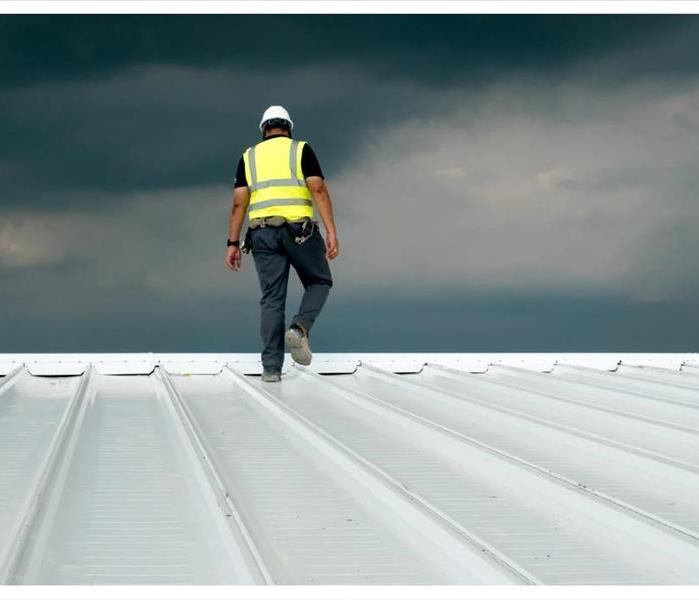 It’s recommended to inspect the roof at least twice a year
It’s recommended to inspect the roof at least twice a year
3 Tips To Protect a Commercial Roof
When it comes to your Churchville, PA, business, protecting it from roof damage can help save valuable time and money by preventing long term problems. There are a few things you can do to help ensure any small issues are found and fixed before repair needs get out of hand.
1. Inspect It Regularly
It’s recommended to inspect the roof at least twice a year, or any time you suspect there may be storm or wind damage. Look for areas of loose or torn shingles, unsecured gutters, or sun spots as these could indicate a problem. If a damaged space is found it's best to cover over the area to prevent further issues and contact a professional for repairs.
2. Cover Over Damaged Areas
Any time roof damage is found it’s best to protect the space to prevent additional problems. If left unprotected additional damage can occur from sun, rain or wind and accumulate until a potential roof rebuild is the needed. Covering over the space with ply-board or a heavy tarp can add protection until a professional can finish repairs.
3. Make Repairs Quickly
It’s important to make repairs as quickly as possible whenever you find damage to the roof. This can help prevent further damage from occurring and creating a large scale problem. You can contact a local storm damage restoration service to help with clean up and repairs. These professionals may also be able to recommend mitigation tips for the future.
Protecting your company from roof damage may help you prevent large scale problems. Remember to have the roof inspected regularly, especially after large storms. Cover over any damage that is found to protect it until repairs can be made, and call a restoration service to have repairs made as quickly as possible. These steps may help prevent larger problems that could lead to the need for a roof replacement.
SERVPRO Encourages Lehigh Valley Property Owners to Prepare Now for Severe Spring Weather
3/2/2020 (Permalink)
SERVPRO® of Easton, Bethlehem & Whitehall
800-455-9453
SERVPRO Encourages Lehigh Valley Property Owners to Prepare Now for Severe Spring Weather
Local disaster remediation specialist cautions warming temperatures threaten to trigger thunderstorms, snow melt, and flooding
Lehigh Valley, Pennsylvania (Grassroots Newswire) 2 March 2020— According to the Federal Emergency Management Agency (FEMA), flooding is the most common natural disaster in the U.S.(1) Dawn and Steve Davis of SERVPRO of Easton, Bethlehem & Whitehall want local home and business owners to know that the approaching spring season is notorious for flood-producing weather, so now is the time to prepare for the unpredictable.
“The water damage caused by a broken pipe, malfunctioning clothes or dishwasher, backed up gutters, or damaged roof is typically limited in scope and pretty straightforward to deal with,” says Davis. “Depending on where you live and work, however, you may also be at risk for flooding caused by rain, melting snow, coastal storms, storm surges, overflows of dams, ice jams in rivers, or a severe spring storm. Those are the types of flooding risks you need to plan for in advance.”
While some areas are more prone to flooding than others, FEMA warns that everyone lives in an area with some flood risk, so it’s important to understand your risk and take the appropriate steps to prepare. You can discover the flooding risk for your specific home or business address here(2), but even those who live in a “low flood risk” zone should heed weather warnings. Here are some of spring’s common flood-related weather hazards and where they are most likely to occur.
• Thunderstorms: The Southeast sees the greatest number of thunderstorms while the West Coast sees the fewest. They occur most often in the spring and summer months during the afternoon and evening hours but can occur anywhere and anytime. These powerful storms can dump large amounts of rain in a short period of time, resulting in flooding and power outages. In an average year, the U.S. experiences about 100,000 thunderstorms.(3)
• Snow Melt: Areas of the U.S. that receive a lot of snowfall are subject to flooding from snow melt. As warming temperatures melt the snow on top of frozen ground, water can pour into basements and flood yards and streets. Communities downstream of heavy snowpack areas are at flooding risk from streams and rivers swollen with melted snow and ice. Communities along rivers are subject to flooding due to ice jams that block the river’s flow.
• Coastal Flooding: Flooding events during or following a coastal storm are common, but changes in average sea level and ongoing development have led to a new phenomenon for coastal communities—Blue Sky or Sunny Day Flooding. Spring is one of the times when this phenomenon occurs, when the Moon’s orbit brings it closest to the Earth, and the Moon, Sun and Earth align, resulting in extraordinarily high tides. Coastal flooding is most common along the Northeast and Gulf Coasts.
“It’s great to look forward to the warmer days of spring, but it’s also important to remember that this change in the weather can trigger some unsettled and even dangerous weather,” says Davis. “Prepare now for the risk of flooding events by making an emergency plan for meeting up with loved ones, storing fresh water in the event of water supply contamination, having fresh batteries on hand in case of power outages, and stockpiling non-perishable food.”
According to the Centers for Disease Control, floodwaters can pose several health risks and cause injuries, infections, chemical hazards, and more.(4) Never drive through flooded roadways, and avoid contact with floodwaters when possible as it may contain downed power lines or electric current from a home or business; human or livestock waste; household, medical, or industrial hazardous waste; debris; or wild animals such as rodents and snakes. If the water has entered a structure through the flooding of a creek, stream or river, or if it has filtered through insulation during its intrusion, it is also to be considered black water and could be hazardous to your health.
“If your home or business is affected by a flood, remember, quick action is critical to minimizing damage and long-term health risks,” Davis says. “Add SERVPRO of Easton, Bethlehem & Whitehall to your contact list in your phone. We’re here to help.”
SERVPRO specializes in disaster restoration, cleanup, and repair services, helping to remediate damage, making it “Like it never even happened,” for both commercial and residential customers. For more information on SERVPRO of Easton, Bethlehem & Whitehall, please contact us at 800-455-9453. For more information on SERVPRO, please visit www.SERVPRO.com.
(1) www.fema.gov/news-release/2004/08/16/flooding-americas-1-natural-hazard
(2) www.floodsmart.gov/flood-map-zone/find-yours
(3) www.nssl.noaa.gov › education › svrwx101 › thunderstorms
(4) www.cdc.gov/healthywater/emergency/extreme-weather/floods-standingwater.html
About SERVPRO
Founded in 1967, the SERVPRO franchise system is a leader and provider of fire and water cleanup and restoration services and mold mitigation and remediation. SERVPRO’s professional services network of more than 1,700 individually owned and operated franchises responds to property damage emergencies ranging from small individual disasters to multi-million dollar large-loss events. Providing coverage in the United States and Canada, the SERVPRO system has established relationships with major insurance companies and commercial clients, as well as individual homeowners.
SERVPRO’s Disaster Recovery Team mobilizes from across the country, as needed, to support large storm events. SERVPRO’s Disaster Recovery Team has responded to large loss and storm events across the country, including: 2018 California Wildfires, 2018 Hurricane Michael, 2018 Hurricane Florence, 2017 Hurricane Irma, 2017 Hurricane Harvey, 2016 East Tennessee Wildfires, 2016 Hurricane Matthew, 2016 Louisiana Flooding, 2016 Houston Flooding, 2015 Siberian Express, 2014 Mid-Atlantic Flooding, 2014 Polar Vortex, 2013 Colorado Floods, 2013 Alberta, Canada Floods, 2012 Hurricane Sandy, 2012 Hurricane Isaac, 2011 Hurricane Irene, and Tropical Storm Lee.
Snow Predictions in the Lehigh Valley for 2019- 2020 Winter Season
10/15/2019 (Permalink)
 Snow Predictions in the Lehigh Valley
Snow Predictions in the Lehigh Valley
We are coming towards the end of October, which means winter is slowly creeping up on us. This winter season, we want you to be prepared on how cold it will be and when the snow might start.
Here’s what we know:
How cold will this winter be?
On an October day when the Lehigh Valley was sweating in 90-degree temperatures, AccuWeather released its long-range winter 2019-20 forecast. According to the forecast: The Northeast as a whole will experience some chilly spells in December, but the real cold comes early in 2020. Above-normal snowfall is expected from New York City to Boston, with rain mixed with snow more likely in Baltimore and Washington, D.C., which will likely put the Lehigh Valley right around the dividing line.
When will we see the first snow?
Data from the National Weather Service shows that the Lehigh Valley on average sees its first snow around Dec. 2. But the actual first-snow date here has a fairly wide range. The earliest measurable snowfall of the season was an inch that fell on Oct. 10, 1979. The latest, on the other hand, was during the winter of 1999-2000 when snow held off until Jan. 13.
While AccuWeather says the first snow should arrive on time, its 2019-20 winter forecast says the worst wintry weather will be delayed: The harshest cold is expected after New Year’s, along with storms and above-average precipitation.
Be Prepared with Team EBW!
SERVPRO of Easton, Bethlehem & Whitehall
800-455-9453
What to Expect for Winter 2019-2020
9/23/2019 (Permalink)
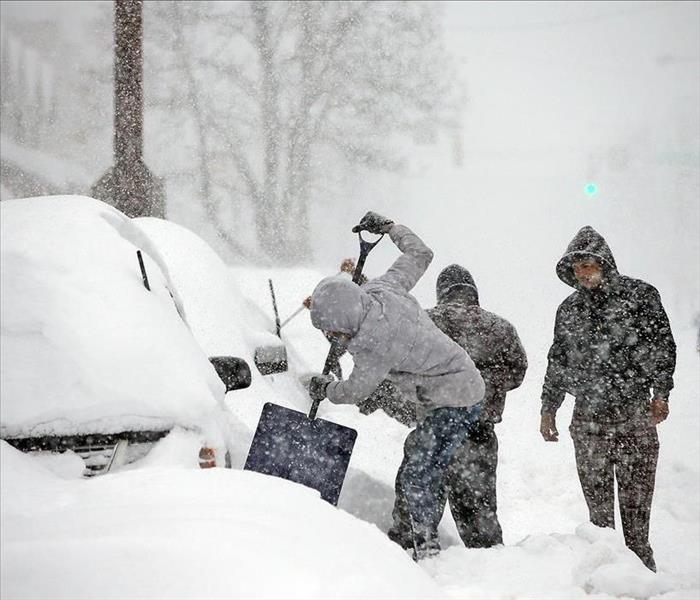 Winter is just around the corner.
Winter is just around the corner.
It’s the most wonderful time of the year- the countdown the Christmas begins. But, while we are all dreaming of a white Christmas, here is what to expect this winter according to the Farmers’ Almanac.
The 2020 edition of the Farmers' Almanac predicts that two-thirds of the country will face a colder-than-normal winter season. The worst of this year's bitterly cold winter will affect the eastern parts of the Rockies all the way to the Appalachians. The outlook says the Northeast, including cities such as Boston and Washington, can anticipate colder temperatures than typically expected. The biggest drop will happen in areas across the northern Plains to the Great Lakes. "With colder-than-normal temperatures in the Northeast and above-normal precipitation expected, our outlook forewarns of not only a good amount of snow, but also a wintry mix of rain, sleet—especially along the coast," the long range forecaster suggests. People in the western third of the US may be in luck, since the publication forecasts near-normal winter temperatures there.
When will the cold winter begin? The coldest conditions are expected to arrive during the last week of January and stick around through the beginning of February. The eastern half of the US will have a suspenseful start in 2020. The Farmers' Almanac predicts strong and gusty winds. Depending on where you live, January 4-7 and 12-15 could have "copious amounts" of snow, rain, sleet and ice.
What will this mean for spring 2020? Be prepared to stay bundled for a while. This year's winter will cause a slow start to a spring season, according to the Farmers' Almanac. People in the Midwest, Great Lakes, Northeast and New England should expect winter to linger.
Be prepared to bundle up! Stay warm! – SERVPRO Easton, Bethlehem & Whitehall – 800-455-9453
Effects of Hurricane Dorian 2019
9/23/2019 (Permalink)
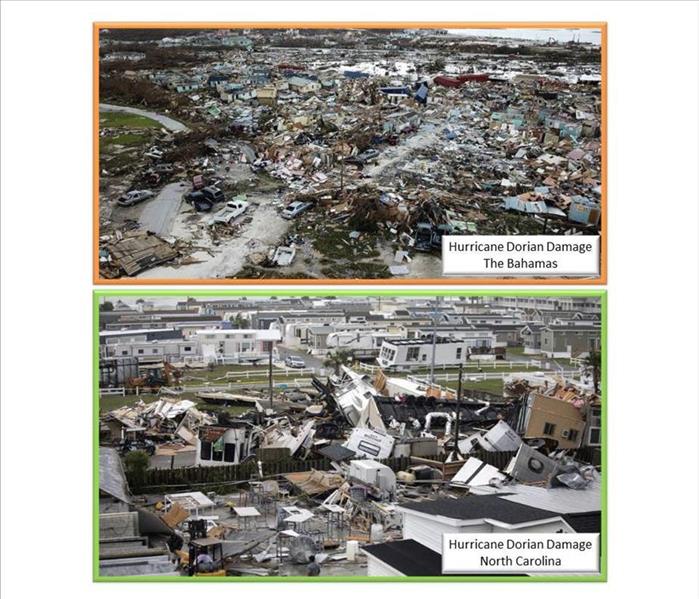 Hurricane Dorian 2019
Hurricane Dorian 2019
As hurricane Dorian set out to sea again, we should still be aware of all the damage that was caused and all the people whose lives were affected by the hurricane.
Fast Facts about Hurricane Dorian
- Relief efforts intensified in the northern Bahamas, which were decimated by then-Category 5 Hurricane Dorian for 48 hours, leaving an estimated 70,000 people homeless.
- The Bahamas death toll rose to 45 and was expected to keep climbing. Thousands remained unaccounted for.
- Dorian made landfall Saturday evening in Nova Scotia as a post-tropical cyclone and still had hurricane-force winds.
- Hundreds of thousands of homes and businesses lost power in Canada; it may take days to restore service.
The U.S. National Hurricane Center declared what was Hurricane Dorian "fully extra-tropical" in what the center said would be its last advisory on the storm. As of 11 p.m. ET Sunday, September 8, 2019, the center said Dorian's core was "over the cold waters of the Labrador Sea" off Canada. It was about 375 miles north of Cape Race, Newfoundland, racing east-northeast at 24 mph with tropical storm-force winds of 60 mph. It was expected to keep weakening and be absorbed by a larger low pressure system Tuesday. Dorian became a hurricane August 28, hit the Virgin Islands, brought catastrophic damage to the northern Bahamas, and then briefly made landfall over North Carolina's Outer Banks as it moved up the U.S. seaboard on its way to Canada. Floodwaters have receded in the Outer Banks, revealing a muddy trail of damage.
The humanitarian crisis in the Bahamas is growing increasingly dire almost a week after Hurricane Dorian made landfall. The death toll now stands at 43 and is expected to significantly rise. Food, water and other supplies are rapidly running out. The U.S. Coast Guard said it has rescued at least 290 people in the Bahamas since the hurricane devastated the string of islands this week. Six MH-60 Jayhawk helicopters conducted search and rescue operations and provided logistical support.
A tropical storm warning was issued Thursday, September 12, 2019 for the Bahamas, less than two weeks after Hurricane Dorian devastated the commonwealth's northwest region as a Category 5 hurricane. The U.S. National Weather Service issued an advisory warning that tropical storm conditions are expected in the northwest Bahamas, including the Abaco Islands, by late Friday. No significant storm surge is anticipated as the storm is only predicted to give off two to four inches of rain.
Stay Safe! – Your SERVPRO of Easton, Bethlehem & Whitehall Team
800-455-9453
Types of Weather Damage to Be Aware of in the Lehigh Valley
9/20/2019 (Permalink)
SEVERE WEATHER & STORMS
High-speed wind gusts, heavy rainfall or a combination of both pose a higher risk for property destruction than your basic rain shower. Severe weather storms including thunderstorms, flash floods, hurricanes, hail and tornadoes far surpass average storms with their sheer force and potential for damage.
TYPES OF SEVERE WEATHER TO BE AWARE OF
- Thunderstorms Severe thunderstorms generate wind gusts greater than 57.5 mph. Winds of this speed can damage shingles, break windows, knock down trees and leave your home susceptible to water damage.
- Flooding In the right conditions, storms can generate immense amounts of precipitation that quickly saturate the ground, overwhelm drainage systems and swell waterways. Rapidly rising water can easily inundate homes, where it may stay for hours or days before receding.
- Hail storms Hail storms can cause immense damage to the structure of your home, ranging from creating vulnerabilities in the protection of shingles or siding to clear holes in your roof, windows or walls.
Severe weather can be scary, and the damages to your home can be even worse. When a harsh weather event impacts your home, SERVPRO of Easton, Bethlehem & Whitehall can take care of your water damage needs, as we are always watching the storm patterns and ready to react in your time of need.
WINTER WEATHER
In addition to freezing temperatures, winter weather conditions can include rain, heavy snowfall, ice dams, sleet and blizzards. Dents from hail, roof damage from ice dams, and flooding from frozen and burst pipes and snowmelt are just a few examples of the potential damages that can be wrought by severe winter weather.
WINTER WEATHER TERMS TO KNOW
- Wind chill advisory Issued when wind chill temperatures are expected to be a significant inconvenience to life with prolonged exposure, and if caution is not exercised, could lead to hazardous exposure.
- Wind chill warning Issued when wind chill temperatures are expected to be hazardous to life within several minutes of exposure.
- Dense fog advisory Issued when fog will reduce visibility to ¼ mile or less over a widespread area.
- Blizzard warning Issued for sustained or gusty winds of 35mph or more, and falling or blowing snow creating visibilities at or below ¼ mile. These conditions should persist for at least three hours.
- Winter storm watch Alerts the public to the possibility of a blizzard, heavy snow, heavy freezing rain or heavy sleet. Usually issued 12 to 48 hours before a storm begins.
- Winter storm warning Issued when hazardous winter weather in the form of heavy snow, heavy freezing rain or heavy sleet is imminent or occurring. Usually issued 12 to 24 hours before event.
If you ever find yourself in need of Storm Damage Restoration services, call SERVPRO of Easton, Bethlehem & Whitehall at 800-455-9453
Avoid Storm Damage to Your Roof
9/18/2019 (Permalink)
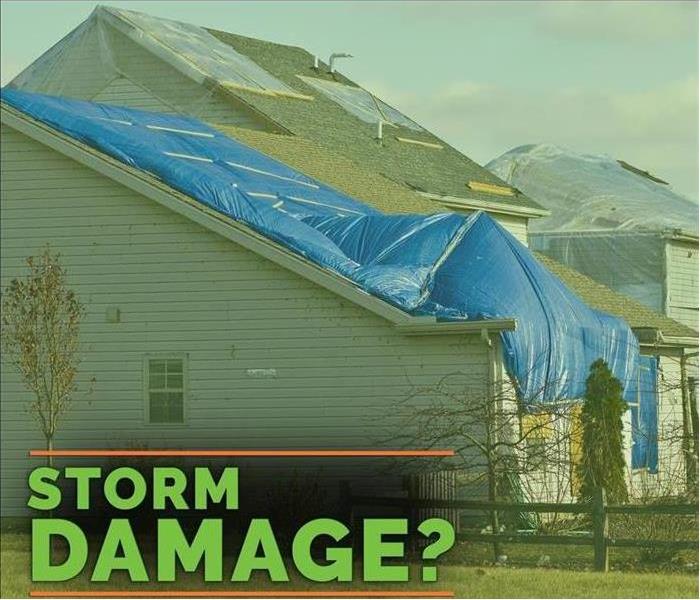 Storm Damage?
Storm Damage?
Fast winds can be detrimental to the structural integrity of your property. When the winds get fierce, they can tear a roof right off your house. Roofs on houses are made to fight normal wind conditions in your area. But if a wind storm is fierce, your roof will only be able to take so much to stay intact.
Why Are Roofs Ripped Off During Storms?
Having a secure and stable roof during a storm is the best way to have peace of mind. Although it cannot be made certain, having a strategy in place for damage prevention is vital for beneficial results. Understanding storms and how they impact your house is the first step in knowing how to stop your roof from becoming damaged.
The atmospheric pressure beneath the roof is an important role in this. If the wind gets inside your home from a doorway, or if outside debris breaks a window, this will form a high-pressure scenario inside and it will push upwards towards your roof. Then you’ll have a push from inside the house and a pull from on top of the roof. This tug-of-war is how tiles get torn off, or in the worst case, your roof tears off from the rest of the house.
That is why it’s critical to, not at any time, open your windows or doors during a heavy storm. It was believed that letting the wind flow directly through your house was a good thing to do, but this assumption has been disproved. Bracing your windows and doors helps maintain normal atmospheric pressure, prevents flying debris from smashing windows and holds off high-pressure winds. In addition, the complications from wind pressure on your roof rest on your roof’s height, style, and location.
How to Fight Storm Damage to Your Roof
Having your roof analyzed for damaged spots and areas of concern that can be fixed ahead of time will help eliminate wind damage when a storm strikes. Eradicating the primary point of access for the wind means you can prevent damage to your roof while the storm continues. Precautionary steps may take up some time but the rewards of an unscathed roof are worth it. A roof that has been analyzed and repaired correctly holds a better chance to withstand high wind conditions.
Nevertheless, we know that you can only do so much and the forces of nature always give us a surprise. If you, or someone you know, experiences roof damage after a storm and find debris and water in your home, call SERVPRO of Easton, Bethlehem & Whitehall for damage restoration services. We will help you put the pieces together again and get your house back to a preloss condition as quickly as possible. Contact us at 800-455-9453 to make it “Like it never even happened.”
Flood Insurance Update - What to do with the new wave of information
8/28/2019 (Permalink)
Living by the water has many rewards. But like most things in this world, those beautiful sunrises and long walks on the beach come at a premium – a flood insurance premium to be exact. Additionally, residents can find getting the right type of coverage from the right carrier isn’t always cut and dry.
There is also the paramount decision of whether to get a policy from the private market or one backed by a federal government program. According to Dawn Becker-Durnin, CSRM, with NFP Insurance with headquarters in Easton, Pennsylvania, the Flood Insurance market is one that is continually changing. The newest update, she explained, at the time of this article, currently surrounding the National Flood Insurance Program (NFIP) is a bill introduced on June 10, 2019 by ranking member of the House Committee on Financial Services, Congresswoman Maxine Waters (D-CA), titled H.R.3167-National Flood Insurance Program Reauthorization Act of 2019. “This bill is reauthorizing the NFIP until the end of the fiscal year of 2024 which is September 30th of that year,” said Becker-Durnin.
She went on to explain that “the bill includes increased budgeting for mapping, right to appeal and basis to appeal existing maps, increasing the Cost of Compliance from $30,000 to $60,000 as well as coverage for Cooperatives on the same terms as a condominium. Small loan exceptions to Mandatory Purchase Requirements from $5,000 to $25,000 as well as Frequency of Payment Collection amendment from annual to monthly installments. The bill also includes a Continuous Coverage provision allowing borrowers to leave the NFIP to purchase flood insurance privately with the ability to return to NFIP without incurring a penalty.”
Becker-Durnin is quick to point out that the provision is somewhat of a game changer. “The disadvantage to private flood insurance is it is not considered continuous coverage. You lose your grandfathered rate. Hopefully if this bill is passed, they are actually going to state that private insurance will be considered continuous coverage — which is a big deal,” she said.
Part of what makes flood insurance policies so hard to understand is that not everyone needs flood insurance, it is separate from the homeowners policy, and is the responsibility of whomever is on the master deed for an association. “Flood insurance is excluded under property coverage. If a typical condo association that has property coverage has a flood exclusion, you need to go and look at the mapping. Because if a particular condo is in a flood zone, a mortgage lender is going to require flood insurance. The duty of obtaining flood insurance falls on the condo association. Unit owners, even if they are responsible for the interior of their units, wouldn’t be able to purchase building coverage,” explained Becker-Durnin.
Becker-Durnin walked us through a typical protocol that she follows for someone buying flood insurance. “First we would pull a flood zone determination by address of the master deed,” she said. Interestingly enough, each building in the association has to be insured separately. “One building could be located a thousand feet away from anther building, and they could actually be in two different flood zones,” said Becker-Durnin. “Then depending on the rating, the premium is decided,” she explained. “The association gets the flood insurance through NFIP. We ask for the elevation certificate. We bring that back to the flood insurance underwriter. They plug all the elevation numbers into their modeling system and come back with their rate quote.”
If $250,000 per unit is not enough to replace the property, purchasing “excess flood” insurance through the private sector may be the best option. “Excess flood means it’s over the primary flood. Instead of purchasing through NFIP, a community can go and obtain private insurance,” Becker-Durnin said.
Think you don’t need flood insurance? Becker-Durnin said that is worth rethinking. As only about 17% of buildings are insured. “For example, during Superstorm Sandy there were areas that were never flooded before. All of a sudden, they had flood waters. Those people were unlikely to be insured because their mortgage companies did not require it and/or they didn’t think their properties would flood,” said Becker-Durnin.
An extra insurance policy is sometimes a steep luxury to property owners. That’s where the NFIP steps in to keep affordable options open. “If NFIP didn’t have this program, communities possibly couldn’t afford flood coverage. Affordability of the insurance can be a real problem. It can actually bring down the value of a neighborhood and hurt resales,” Becker-Durnin added. “NFIP offers insurance for everybody. But of course the pricing is determined by which zone the building is located in and the elevation of the building,” she continued.
No matter how you choose to insure, it has to be for the entire cost to replace the structure. “Flood insurance is for the full replacement of the building. That’s what you need to insure for to avoid penalty,” said Becker-Durnin. “The maximum you can purchase through NFIP is $250,000 per unit with a Residential Condominium Building Association Policy (RCBAP).” However, according to Becker-Durnin “replacement costs on a flood could be higher than others because a property policy doesn’t typically cover foundations. If you have a ten-unit building and the replacement cost is $500,000 per unit, now you are only insuring fifty-percent of the building. If you have a flood, and you are not insuring the building to full replacement cost, the federal government will penalize you and pay out less.”
Much of the determination of premium is based on the elevation certificate. “An elevation certificate is done by a licensed engineer or architect to determine the height of the property above sea level. They have to do this for each building on a property. One building could cost more than the others if that building is lower in elevation or closer in proximity to the coast,” Becker-Durnin said.
Can a board opt to only insure some of their structures that are more of a risk? “The board can make that determination. You have to evaluate the risk. A building that never floods can flood,” she said.
As stated, there is a lot to consider when choosing between the NFIP program and private insurance. There are certainly pros and cons to both. Whether it’s getting a good rate or feeling confident your claim will be paid, according to Becker-Durnin, it’s a tough call.
For example say “your property insurance carrier, because you are in a low-risk area, is willing to include flood via endorsement on your policy. So you can now cancel your NFIP policy. There are a lot of pros and cons with that. One issue is that NFIP wasn’t willing to grandfather the rate. If you canceled and wanted to come back, the map may have changed and the rate could be very different than when you canceled the policy,” said Becker-Durnin.
She also mentioned that there is the possibility of saving money. “The advantage to private insurance is the premiums are typically less than NFIP. With private insurance you can purchase whatever amount you want. It just has to be the replacement cost of the building,” said Becker-Durnin. She went on to point out “if I have private insurance, I most likely don’t have to provide an elevation certificate. Someone can save a couple hundred dollars on having an engineer complete a flood elevation determination if one was not performed in the past”
Private insurance also affords a few extra perks. “Another thing is NFIP only gives about $30,000 for “increased cost of compliance” or ICC, which is the cost to elevate, demolish or relocate if a building is substantially damaged. Flood insurance in the private market can offer higher limits. Also NFIP does not offer coverage if you have to temporarily live somewhere else. If you have to go stay at a hotel, you’re paying for that out of your own pocket. NFIP does not pay for additional living expenses. They also won’t pay for the loss of assessments. There’s no business interruption coverage for that. Private flood insurance can give the additional living expenses and loss of income for the association, which is a big deal,” said Becker-Durnin.
While private insurance can be bound instantaneously if paid in full or over time, the NFIP has a caveat to that. “There’s a thirty-day waiting period with NFIP. The only time NFIP will waive the waiting period is if you have a mortgage closing and/or refinance of a mortgage. The annual policy premium through NFIP has to be paid in full,” said Becker-Durnin. “The private market can also give discounts based upon the type of construction. NFIP doesn’t give premium discounts based upon construction factors,” she added.
Can homeowners have both NFIP and private at the same time? “You can have both. But one is going to say the other is the primary,” said Becker-Durnin.
After all that, you may think private is the way to go. But Becker-Durnin cautioned that getting a policy from a business a private market, especially a non-admitted excess insurer, can lead to a difficult matter when it’s time to make a claim. “The lenders may not accept private insurers, because NFIP is backed by the federal government. Plus the NFIP program the rates are pretty stable,” said Becker-Durnin.
Source: https://associationhelpnow.com/flood-insurance-update-%e2%80%a8what-to-do-with-the-new-wave-of-information/
Preparing for Hurricane Season
8/12/2019 (Permalink)
Preparing for Hurricane Season
That time of year is slowly approaching- the time for endless rain due to hurricanes and tropical storms. Stated in the preseason forecast, “the Atlantic hurricane season now is expected to be above normal, with 10 to 17 named storms, including five to nine hurricanes” the Climate Prediction Center of the National Oceanic and Atmospheric Administration announced on August 08, 2019. Two to four of those hurricanes are forecast to be Category 3 or stronger, with winds greater than 110 mph.
The updated forecast was issued just ahead of the start of the most active hurricane period -- the roughly eight weeks that surround September 10, when hurricane season hits its statistical peak. There is now a 45% chance for above-normal tropical activity this season, the NOAA center said. That's an increase from the 30% chance in its May outlook. Last year saw an above-average Atlantic hurricane season, with Hurricanes Florence and Michael slamming US coastlines with devastating effect. An average season has 12 named storms, with six hurricanes, including three major hurricanes of Category 3 strength or greater.
Here are some tips to help prepare you for the storms:
- Make sure you have plenty of water- stock up on water bottles from your local stores
- Make sure to stock up on extra batteries, flashlights, and store in a waterproof container that is easily accessible
- Keep your refrigerator closed- if you lose power you should keep your refrigerator closed to help save as much food as possible
- Stay away from windows, skylights, and glass doors- go to a safe area in your home
- Come up with a safety plan with everyone in your household- a meeting point to stay together and things you all might need
Stay safe! – SERVPRO of Easton, Bethlehem & Whitehall 800-455-9453
Roof Damage Can Lead to Secondary Damage
11/5/2018 (Permalink)
There are lots of different issues that could cause damage to your home; Roof damage is one of those. Damage due to storms is the most typical, but there are several things that COULD cause the damage to your roof some being more visible than others. It is always good practice to have your roof inspected every 10-12 years, unless there has been a specific issue that may have caused a reason to check it sooner such as a severe storm, hail, or some other sort of natural disaster. Unfortunately, when your roof becomes damaged it can lead to bigger issues that may ultimately cause water damage to the interior of your home.
Here we mention a few things to look for when you are inspecting your roof:
- Loose or missing shingles: this could be caused by high winds, improper installation, or simply wearing out over exposure to the elements through the years. Loose nails can also leave a hole in the shingle that water can find its way through as well.
- Poor installation of the flashing. "Flashing" is the metal that is placed in the sections where the roof meets the walls, or in the valleys. This must be installed properly to divert water from the roof.
- Gutters that are not placed with the right pitch, or that have seems that are not sealed properly can also cause water to back up and then overflow into the house causing water damage to ceilings and/or walls. Not having gutter guards to keep leaves and debris from collecting in the gutters can cause overflow of water that can result in damage to your roof and other areas of your home as well.
- Rotted fascia or soffit can also be an area that allows water to intrude.
If you suspect that you may have roof damage causing water damage to your home please feel free to contact us at (800) 455-9453 and we will be happy to assist you.
SERVPRO of Easton, Bethlehem & Whitehall will be there for all of your home repairs or accidents.
Preparing Your Home for the Cold Weather Storms
10/30/2018 (Permalink)
We have entered heating season in the Lehigh Valley. Cold temperatures can create a negative impact on your home and property; it’s key that you take the necessary precautions for your home not only for cold weather, but for storm season as well in order to limit potential risks and damages. When doing routine maintenance, it’s always better to be prepared and go the extra step to insure that you are limiting risks of damage. It’s important to be thorough while inspecting your building.
- Basements and crawlspaces in your home can be areas where heat escapes. Be sure to seal and insulate around any HVAC ducts, basement windows, and any exposed pipes.
- Try installing foam-rubber gaskets behind electrical outlets & switch covers on exterior walls.
- If you don’t use your fireplace, plug the flue with an inflatable plug, or another item, that is safe and limits possible water to entry into your home.
- Make sure you replace any broken windows, re-putty any loose window panes, seal around windows and door trims, or use weather stripping for windows that are opened. This minor step can make a world of a difference in heat efficiency and preventing water intrusion.
- For attic spaces it’s best to weather strip & insulate the access door properly, seal around your chimney with metal flashing or a high temperature sealant, seal around plumbing vents, seal any holes between the heated space of your home and the attic, and don’t forget to insulate any exposed water pipes!
If water damage occurs in your home due to extreme weather or any other means, make sure to call the team with over 27 years of experience. SERVPRO of Easton, Bethlehem & Whitehall has the crew that is trained and experienced in dealing with not only average water damage but storm water damages to buildings as well. Give SERVPRO of Easton, Bethlehem & Whitehall a call today for your building damages in the Lehigh Valley at (800) 455-9453.
When the Severe Storms Roll Out, SERVPRO Rolls In
9/24/2018 (Permalink)
Unexpected emergencies like severe weather call for immediate action. SERVPRO of Easton, Bethlehem & Whitehall knows immediate reaction to the disaster is important to helping you get your life back to normal.
Utilizing our 1-4-8 Service Response Guidelines we strive to:
- Contact you within 1 hour from notice of loss to arrange for your service.
- Be-on-site to begin mitigation services within 4 hours of notification.
- Provide verbal briefing of scope to you within 8 business hour of on-site arrival.
Exceptions to our 1-4-8 Service Response times may apply under certain conditions, such as a local catastrophic event or storm situation.
We also perform pack-out services, which is removing salvageable personal property from the affected area for off-site cleaning and storage.
If you have storm damage to your home or property, call us today (800) 455-9453. Timely mitigation is the key to minimize secondary damages caused by severe storms.
How Dirty is my Flood Water?
9/20/2018 (Permalink)
Water Has Many Different Uses
We all know that there are many different uses for water. In our household alone, water is used for drinking, sanitation and even sewer purposes. When water damage occurs, it’s important to know where the cause of the damage started so that we’re able to identify the category of the water that we’re dealing with. According to the Institute of Inspection and Restoration Certification, certain categories of water can pose a higher threat than others. The IICRC set the standards for the cleaning industry and water damage restoration. The professionals at SERVPRO of Easton are highly trained by certified IICRC instructors.
Categories of water contamination
Category 1 –
This category of water is also know as “Clean Water”; the most known out of all of the categories. This is the water that is sanitary to drink, cook with and wash in. This water is only sanitary while in it’s source though, such as the pipes in your home. Once it is exposed to other elements, there is a possibility of becoming contaminated.
Category 2 –
Once the water reaches category 2, it usually is noticeable due to foul odor or different look. At this level, the water is unsafe to consume or come in contact with. This category is also known as “Gray Water”. It usually occurs from an overflow of the toilet or other appliances. Do not leave this water unattended for long.
Category 3 –
Category 3, or also known as “Black Water”, is almost always pretty noticeable to point out due to the high level of contamination. Being at this level means that it may contain raw sewage, pesticides, heavy metals or other toxic substances. This high level category is extremely toxic.
It is always important to clean any type of flood or water damage as soon as it is noticed. The longer the water damage sits, the higher risk of the water becoming contaminated and causing illness.
Source - http://www.IICRC.org/the-basics-water-damage-restoration-training-a-23.html
Properly Maintain an Emergency Sump Pump
9/19/2018 (Permalink)
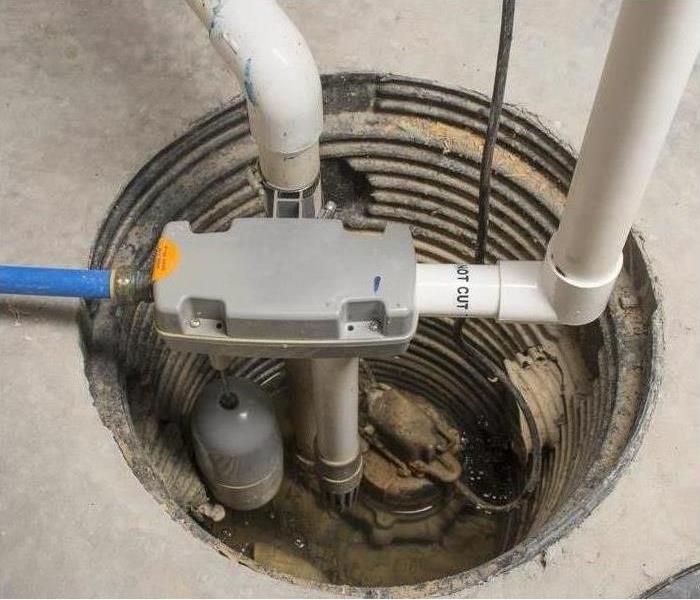 Properly maintain your sump pump to ensure back up after a flood in the Lehigh Valley
Properly maintain your sump pump to ensure back up after a flood in the Lehigh Valley
If you live in the Lehigh Valley where heavy rains and flooding often affect the water tables especially around the rivers, streams, ponds and lakes, then you should become familiar with the value of maintaining flood equipment, such as a backup sump pump. This appliance protects homes with poor drainage, foundation weaknesses, and aging basement walls.
Prepare for Action
When your emergency sump pump is in top condition, it may be able to remove two feet of water at a time from your basement. Keep it ready for action with the following maintenance.
Quarterly Maintenance
• Rinse pump inlet screen and remove dust or debris.
• Visually inspect power cord and power connection.
• Run water through to make sure the float rises, and the pump turns on.
Annual Maintenance
• Schedule professional inspections and maintenance for the sump.
• Read your owner's manual for DIY maintenance, such as greasing pump bearings.
• Remove the pump to thoroughly inspect and clean it. Make repairs as necessary.
• Clean out the rest of the equipment.
• Reassemble the machine.
Protect Your Primary Sewage System
When your primary sewage piping or sump system is at risk, a back up battery pump is crucial. This pump kicks in when water levels are high. It keeps your home safe when too much rain water and debris has overwhelmed your existing drainage system. An emergency battery-powered pump can keep your home safely dry when the power goes out. It may sit on the shelf, unused for months or years at a time, but with appropriate maintenance, it will be ready when you need it.
If a sump pump isn't a possibility, you may be able to work with a remediation professional. These experts often have a truck-mounted trash pump, in addition to the sump.
Act Immediately
The immediate use of this equipment can prevent serious damages, mold growth, and the need for expensive repairs. Protect your Lehigh Valley home and family from standing water, mold growth, and other flooding damages with a second layer of protection. In the event of a flood where you find yourself looking for a professional company to handle the damage, call SERVPRO of Easton, Bethlehem & Whitehall at (800) 455-9453.
The Four Seasons of SERVPRO
9/19/2018 (Permalink)
SERVPRO of Easton, Bethlehem & Whitehall is located in the beautiful State of Pennsylvania. Here we are lucky enough to enjoy all four seasons. But with each season comes difficulties for home and business owners. In the Lehigh Valley we are prone to Snow Storms and Thunder Storms which each provide their own sets of challenges.
Winter often brings power outages from wind, downed trees, or ice which can cause pipes to freeze and split which causes flooding to homes and businesses. Ice dams are also a concern when constant thawing and re-freezing causes water to creep into to a buildings roof and go un-noticed. The water may keep coming in until the snow or ice is removed from a roof.
Spring, Summer, and Fall are the worst when it comes to storm seasons. From Tornado season to Hurricane season, SERVPRO of Easton, Bethlehem & Whitehall is always on alert when it comes to storms. Wind that causes roofing and siding to blow off a building often open up the structure for rain to come in affecting the home with water damage. High winds also leave the potential for trees to come down on structures and cause significant damage throughout the structure when it is open to the elements. Lightning strikes leave a potential for a fire which is rare, but does happen. The most common issue we see from storm damages would be from the flooding. Most issues are a result of an abundance of high flood levels. Keep in mind the fact that even with a sump pump, there is a chance that they may not always work. For example a power outage during a heavy rain storm where a sump pump may not work without a backup in place. And last but not least would be sewage backups in homes during times of heavy rain or flooding. This is a serious matter which we see all too often and most people are unsure where to even begin.
Please do not WAIT until it's too LATE! Usually weeks after storms may have passed and water damage has gone un-noticed in a home or business, we receive calls to come out and estimate Mold Remediations.
Above all, make your safety top priority.
Remember to call the brand that you know and trust to take care of any storm damage that you may have suffered.
Call our local office of SERVPRO of Easton, Bethlehem & Whitehall at (800) 455-9453.
Quick Response and High Standards Will Leave you Satisfied after Remediation
7/26/2018 (Permalink)
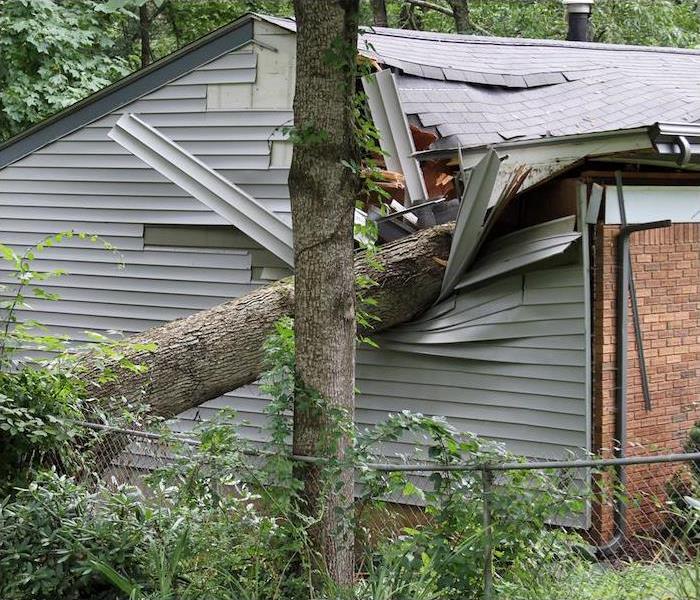 SERVPRO of Easton, Bethlehem and Whitehall is ready to deal with any size storm damage. Call today!
SERVPRO of Easton, Bethlehem and Whitehall is ready to deal with any size storm damage. Call today!
When heavy rains and high winds hit hard, property destruction and loss can be devastating to you as a home or business owner. Structural damage to the exterior of your home or building is followed by interior devastation from water and winds. Storm damage is rarely isolated to just a few buildings in an area adding the challenge of finding a restoration company that can respond swiftly to your needs to an already anxiety provoking situation. SERVPRO of Easton, Bethlehem & Whitehall delivers the help you need quickly even when a local disaster is widespread as we are able to call upon a network of over 1,700 franchises nationwide to respond if the need is great.
Storm damage in the Northeast can feel overwhelming, but your fear and panic will disappear when our team of professionals responds to your water, wind and flooding repair and restoration needs. Your particular situation is of paramount importance to us, and you need not worry that your repairs and restoration will take a back seat even when many in your area are struggling to recover from the same issues you face. Choosing our company puts in motion a vast support system, but our local ownership means you will receive a personalized approach to your particular situation, efficiently returning your home back to its pre-storm condition just “Like it never even happened.”
Placing your trust in SERVPRO for your storm damage needs will reap you benefits that less qualified companies simply cannot deliver. We use state of the art equipment to clean, repair and restore your home and in the process, we also restore your and your family’s peace of mind. Our technicians are highly trained and qualified, current in Institute of Inspection Cleaning and Restoration Certification (IIICRC) for any procedure needed to bring your home back to the comfortable and comforting refuge you deserve. We also work closely with your insurance company, ensuring that all the work necessary is approved and compensated according to the terms of your policy. Our high standards and relentless drive to do the job on time while meeting local specifications means you and your family will quickly return to the quiet enjoyment of your house and neighborhood. We are not satisfied until you are happily back in your restored dwelling.
Once you make sure that your family is safe after a major storm, your first call should be to SERVPRO of Easton, Bethlehem & Whitehall. Dial (800) 455-9453 24/7 and begin the road to recovery by scheduling an inspection with our storm damage experts.
Lehigh Valley - Things You Might Not Expect from Storms
5/18/2018 (Permalink)
Storms of all kinds are just a part of life. We usually know they are coming, and we know things will get wet and blown about. Sometimes there will be flooding in low-lying areas, and for the folks who live in those places, that’s to be expected, although certainly not something anyone looks forward to. But you know what to prepare for, and so you do. You check windows and doors, drainage systems, and you make sure everyone you care about knows what to do in those events. So far, so good.
But what about those storm events that cause things to happen that just didn’t seem possible, or that you weren’t looking for?
After a severe rainstorm, your property can suffer from an infestation of insects, for example. They might be seeking higher ground, or their nests were destroyed and they need to build again. Not something you would be thinking about, but it can happen! Make sure you know who to call if you develop a problem like that!
In the event of hurricanes and tornadoes, large items can end up in the strangest places! We’ve all heard stories or seen pictures of cars up in trees, or an entire outdoor table and chair set sitting in another yard down the street. This, too, is not something you would expect. What will you do if that happens? A professional cleaning company such as the team at SERVPRO of Easton, Bethlehem & Whitehall is ready and waiting to help you if your neighbor’s stuff ends up on your property!
Some of the things that can happen are pretty scary, such as branches driven through walls, trees falling on roofs, or extremely large hail falls. Before storm season, maybe think about weather events that could happen, and make some plans. Do you have a safe place for your larger machinery and cars in case of extreme weather? Do you have enough non-perishable food items in case of longer-than-normal power outages? If you have elderly neighbors, do you know who would be helping them if they were in trouble? Does that huge tree in your yard look like a liability? Safety is serious business!
We are always ready to help in the event of water or fire damage here at SERVPRO of Easton, Bethlehem & Whitehall (800-455-9453).
Quick Response and High Standards Will Leave you Satisfied after Remediation
5/4/2018 (Permalink)
Quick Response and High Standards Will Leave you Satisfied after Remediation
When heavy rains and high winds hit hard, property destruction and loss can be devastating to you as a homeowner. Structural damage to the exterior of your home is followed by interior devastation from water and winds. Storm damage is rarely isolated to just a few buildings in an area adding the challenge of finding a restoration company that can respond swiftly to your needs to an already anxiety provoking situation. SERVPRO delivers the help you need swiftly even when a local disaster is widespread as we are able to call upon a network of 1,700+ franchises nationwide to respond if the need is great.
Storm damage can feel overwhelming, but your fear and panic will disappear when our team of professionals responds to your water, wind and flooding repair and restoration needs. Your particular situation is of paramount importance to us, and you need not worry that your repairs and restoration will take a back seat even when many in your area are struggling to recover from the same issues you face. Choosing our company puts in motion a vast support system, but our local ownership means you will receive a personalized approach to your particular situation, efficiently returning your home back to its pre-storm condition just “Like it never even happened.”
Placing your trust in SERVPRO for your storm damage needs will reap you benefits that less qualified companies simply cannot deliver. We use state of the art equipment to clean, repair and restore your home or business to its preloss condition. Our technicians are highly trained and qualified, current in Institute of Inspection Cleaning and Restoration Certification (IIICRC) for any procedure needed to bring your home back to the comfortable and comforting refuge you deserve. We also work closely with your insurance company, ensuring that all the work necessary is approved and compensated according to the terms of your policy. Our high standards and relentless drive to do the job on time while meeting local specifications means you and your family will quickly return to the quiet enjoyment of your house and neighborhood. We are not satisfied until you are happily back in your restored home or business.
Once you make sure that your family is safe after a major storm, your first call should be to SERVPRO of Easton, Bethlehem & Whitehall. Dial (800) 455-9453 anytime during the day or night and begin the road to recovery by scheduling an inspection with our storm damage experts.
 Winter weather in the Lehigh Valley can cause frozen pipes, ice dams, and puffbacks, leading to serious property damage.
Winter weather in the Lehigh Valley can cause frozen pipes, ice dams, and puffbacks, leading to serious property damage.





 24/7 Emergency Service
24/7 Emergency Service
